Paul van Yperen's Blog, page 354
February 21, 2016
Lucia Bosé
Lucia Bosé (1931) is an Italian actress, famous for her films from the 1950s with a.o. Giuseppe De Santis and Michelangelo Antonioni. In the same years and after she also worked with other famous directors such as Juan Bardem, Luis Buñuel, the Taviani brothers, Liliane Cavani, Francesco Rosi and Ferzan Özpetek.
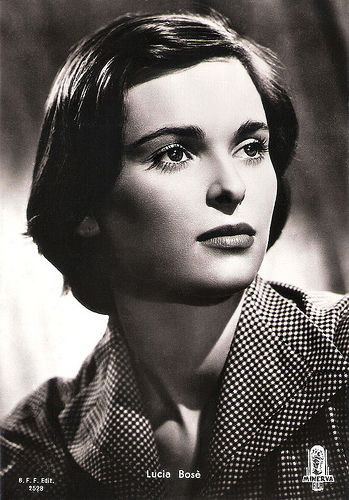
Italian postcard by Ballerini & Fratini Editori, Firenze, no. 2528. Photo: Minerva Film.
Miss Italy
Lucia Bosè was born Lucia Borloni in Milan, Italy in 1931. She comes from a peasant and working-class family and began to work at the age of twelve years. She was first a messenger for a law firm, later a clerk in Milan's fine pastry shop Galli.
In 1947 she participated in the first Miss Italy pageant, where she was able to win against competitors like Gianna Maria Canale , Eleonora Rossi Drago and Gina Lollobrigida .
Had Giuseppe De Santis still preferred Silvana Mangano for Riso amaro/Bitter Rice (1949), he chose Bosè for his next film, Non c'è pace tra gli ulivi/No peace among the olive trees (Giuseppe De Santis, 1950), a typical Neorealist film about a poor shepherd ( Raf Vallone ) who tries steal back his sheep stolen from him while he was at war.
In the same year Bosé starred oposite Massimo Girotti in the well-to-do set, modernist crime story and drama Cronaca di un amore/Story of a love affair (Michelangelo Antonioni, 1950). It was Antonioni's first full length feature film, about an adulterous couple plotting to kill her husband.
Numerous screen engagements followed. Antonioni cast her again in La signora senza camelie/The Lady Without Camelias (Michelangelo Antonioni, 1953) about a newly discovered starlet and her experiences of in the Italian cinema. Juan Bardem cast her in Muerte di un ciclista/Death of a Cyclist (1955) about an adulterous couple which runs over a cyclist and leaves him to die. Bosé also acted in Francesco Maselli's debut Gli sbandati/The Abandoned (1955) and Luis Buñuel's Cela s'appelle l'aurore/That Is the Dawn (1956).
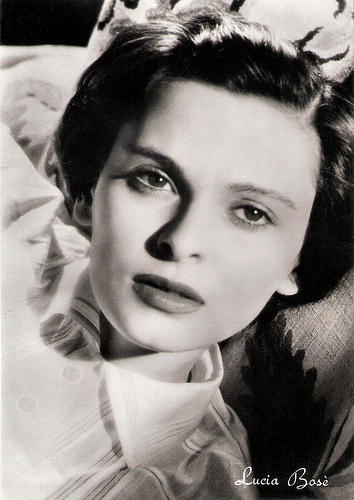
Italian postcard by Italfoto, no. 162.
Bullfighter
In 1955 Luci Bosè married Luis Miguel Dominguín, a five years older, popular Spanish bullfighter and occasional actor. From the marriage, which ended in a divorce in 1967, sprang three children, two of whom - Paola Dominguin and Miguel Bosé - are also active as actors. Luchino Visconti was godfather to her son Miguel, Pablo Picasso to her daughter Paola.
At the time, Lucia Bosè lived in Spain and put her career on halt, except for a sporadic appearance in Le testament d'Orphée/Testament of Orpheus (Jean Cocteau, 1959).
In 1968 Bosé returned to film acting after almost a ten year break and worked first in Spain and afterwards in Italy. There she worked among others in Federico Fellini's Satyricon (1969), the Taviani Brothers' Sotto il segno dello scorpione/Under the Sign of Scorpio (1969), and Liliana Cavani's L'ospite/The Guest (1972).
Other interesting films with her were Nathalie Granger (Marguerite Duras, 1972), Lumière ( Jeanne Moreau , 1976) and Violanta (Daniel Schmid, 1977).
After 1978, she acted significantly less, but remained active, also on television. She had memorable film performances in Cronaca di una morte annunciata/Chronicle of a Death Foretold (Francesco Rosi, 1987) starring Rupert Everett , El niño de la Luna/Moon Child (Agustí Villaronga, 1989), Harem suaré/Harem (Ferzan Özpetek, 1999) and I vicerè/The Viceroy (Roberto Faenza, 2007).
Her most recent screen appearance was in Alfonsina y el mar/One more time (Pablo Benedetti, David Sordella, 2013), as an 80-year-old actress who returns to the small Chilean town of her youth to fulfill her father's dream of creating a TV channel in a place which has never known television.
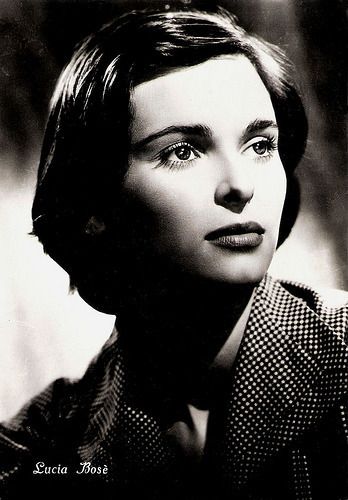
Italian postcard in the series Divi del Cinema by Vetta Traldi, Milano, no. 7.
Scene from Cronaca di un amore/Story of a love affair (Michelangelo Antonioni, 1950). Source: 藤原敏史(YouTube).
Sources: Wikipedia (German, English and Italian) and .

Italian postcard by Ballerini & Fratini Editori, Firenze, no. 2528. Photo: Minerva Film.
Miss Italy
Lucia Bosè was born Lucia Borloni in Milan, Italy in 1931. She comes from a peasant and working-class family and began to work at the age of twelve years. She was first a messenger for a law firm, later a clerk in Milan's fine pastry shop Galli.
In 1947 she participated in the first Miss Italy pageant, where she was able to win against competitors like Gianna Maria Canale , Eleonora Rossi Drago and Gina Lollobrigida .
Had Giuseppe De Santis still preferred Silvana Mangano for Riso amaro/Bitter Rice (1949), he chose Bosè for his next film, Non c'è pace tra gli ulivi/No peace among the olive trees (Giuseppe De Santis, 1950), a typical Neorealist film about a poor shepherd ( Raf Vallone ) who tries steal back his sheep stolen from him while he was at war.
In the same year Bosé starred oposite Massimo Girotti in the well-to-do set, modernist crime story and drama Cronaca di un amore/Story of a love affair (Michelangelo Antonioni, 1950). It was Antonioni's first full length feature film, about an adulterous couple plotting to kill her husband.
Numerous screen engagements followed. Antonioni cast her again in La signora senza camelie/The Lady Without Camelias (Michelangelo Antonioni, 1953) about a newly discovered starlet and her experiences of in the Italian cinema. Juan Bardem cast her in Muerte di un ciclista/Death of a Cyclist (1955) about an adulterous couple which runs over a cyclist and leaves him to die. Bosé also acted in Francesco Maselli's debut Gli sbandati/The Abandoned (1955) and Luis Buñuel's Cela s'appelle l'aurore/That Is the Dawn (1956).

Italian postcard by Italfoto, no. 162.
Bullfighter
In 1955 Luci Bosè married Luis Miguel Dominguín, a five years older, popular Spanish bullfighter and occasional actor. From the marriage, which ended in a divorce in 1967, sprang three children, two of whom - Paola Dominguin and Miguel Bosé - are also active as actors. Luchino Visconti was godfather to her son Miguel, Pablo Picasso to her daughter Paola.
At the time, Lucia Bosè lived in Spain and put her career on halt, except for a sporadic appearance in Le testament d'Orphée/Testament of Orpheus (Jean Cocteau, 1959).
In 1968 Bosé returned to film acting after almost a ten year break and worked first in Spain and afterwards in Italy. There she worked among others in Federico Fellini's Satyricon (1969), the Taviani Brothers' Sotto il segno dello scorpione/Under the Sign of Scorpio (1969), and Liliana Cavani's L'ospite/The Guest (1972).
Other interesting films with her were Nathalie Granger (Marguerite Duras, 1972), Lumière ( Jeanne Moreau , 1976) and Violanta (Daniel Schmid, 1977).
After 1978, she acted significantly less, but remained active, also on television. She had memorable film performances in Cronaca di una morte annunciata/Chronicle of a Death Foretold (Francesco Rosi, 1987) starring Rupert Everett , El niño de la Luna/Moon Child (Agustí Villaronga, 1989), Harem suaré/Harem (Ferzan Özpetek, 1999) and I vicerè/The Viceroy (Roberto Faenza, 2007).
Her most recent screen appearance was in Alfonsina y el mar/One more time (Pablo Benedetti, David Sordella, 2013), as an 80-year-old actress who returns to the small Chilean town of her youth to fulfill her father's dream of creating a TV channel in a place which has never known television.

Italian postcard in the series Divi del Cinema by Vetta Traldi, Milano, no. 7.
Scene from Cronaca di un amore/Story of a love affair (Michelangelo Antonioni, 1950). Source: 藤原敏史(YouTube).
Sources: Wikipedia (German, English and Italian) and .
Published on February 21, 2016 22:00
February 20, 2016
Dita Parlo
Lovely Dita Parlo (1906-1971) was a star of German and French films of the late 1920s and 1930s, who also worked in Hollywood. She inspired both Dita Von Teese and Madonna, the latter used her name and character from L'Atalante (1934) for her Sex book and Erotica album.

German postcard by Ross Verlag, no. 4591/1, 1929-1930. Photo: Atelier Badekow, Berlin.
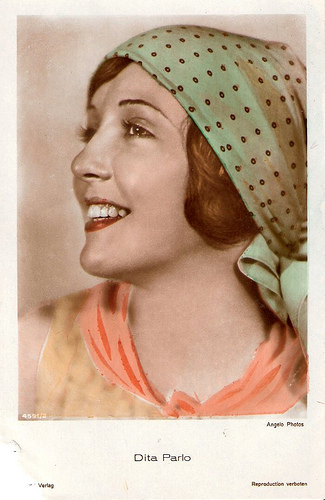
German postcard by Ross Verlag, no. 4591/2, 1929-1930. Photo: Angelo Photos.
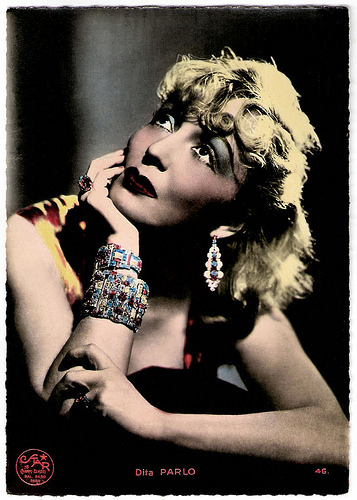
French postcard by Editions O.P., Paris, no. 46. Photo: Star.
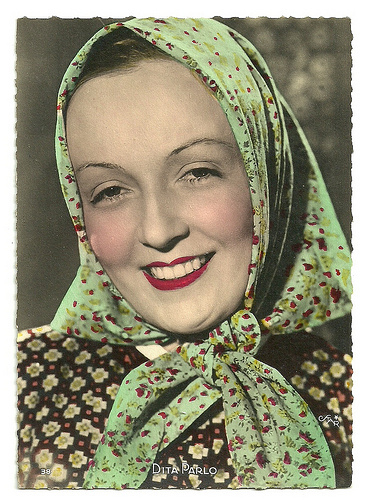
French postcard. Photo: Star. Publicity still for La Grande Illusion (Jean Renoir, 1937).
Ufa Drama School
Dita Parlo was born as Gerda Olga Justina Kornstädt in Stettin, Germany (now Szczecin in Poland) in 1906 (some sources say 1908). Her father was a forest ranger.
Dita was initially trained as a ballet dancer. Subsequently she studied acting at the Babelsberg film school in Berlin. There she was discovered for the screen by producer Erich Pommer and she was signed to a contract with the Ufa studio.
She made her first film appearance as the wife of soldier Lars Hanson in the silent war drama Heimkehr/Homecoming (Joe May, 1928). After her film debut, Dita Parlo quickly rose to stardom.
Her early Ufa films include Geheimnisse des Orients/Secrets of the Orient (Alexandre Volkoff, 1928) with Nicolas Koline and Iván Petrovich , Die Dame mit der Maske/The Lady with the Mask (Wilhelm Thiele, 1928), and Ungarische Rhapsodie/Hungarian Rhapsody (Hanns Schwarz, 1928), with Willy Fritsch .
In Manolescu - Der König der Hochstapler/Manolescu (Victor Tourjansky, 1929), she appeared opposite the legendary Russian film star Ivan Mozzhukhin .
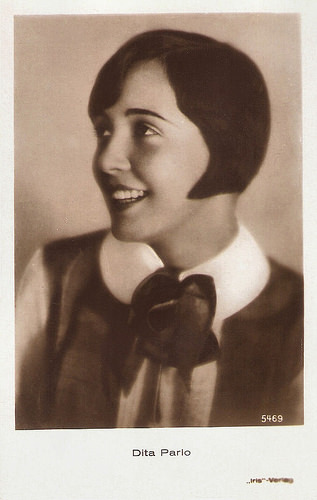
Austrian postcard by Iris-Verlag, no. 5469.
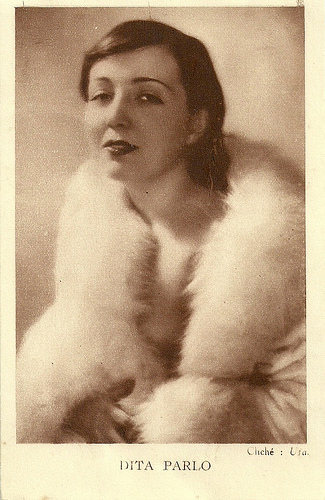
Belgian postcard by S.A. Chocolat & Cacao, Kivou, Vilvo(o)rde. Photo: Ufa.
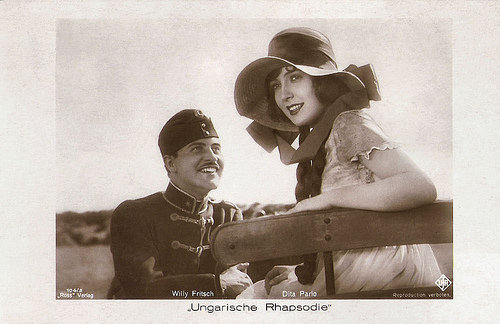
German postcard by Ross Verlag, no. 104/3. Photo: Ufa. Publicity still for Ungarische Rhapsodie/Hungarian Rhapsody (Hanns Schwarz, 1928) with Willy Fritsch .
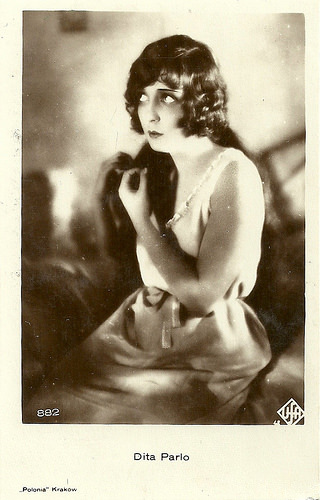
Polish postcard by Polonia, Krakow, no. 882. Photo: Ufa
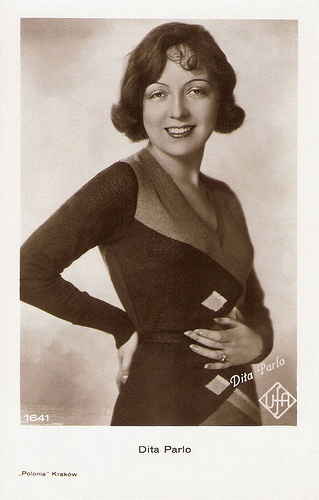
Polish postcard by Polonia, Krakow, no. 1641. Photo: Ufa.
Hollywood
Dita Parlo appeared in the first sound film of the Ufa, Melodie des Herzens/Melody of the Heart (Hanns Schwarz, 1929) opposite Willy Fritsch .
In France she also became popular, and appeared in Au bonheur des dames/For the Happiness of Women (Julien Duvivier, 1930), an adaptation of Emile Zola's 1883 novel of the same name.
In 1931 she tried her luck in Hollywood. She often appeared in German-speaking versions of American films and she played parts in the minor films Honor of the Family (Lloyd Bacon, 1931) with Bebe Daniels, and the comedy anthology Mr. Broadway (Johnnie Walker, 1933). The sketch with Parlo in the latter film was taken from an uncompleted film by Edgar G. Ulmer, titled Love's Interlude. This film was begun in 1932 at Peerless Productions.
After two years in Hollywood and no success, Dita Parlo moved to Paris. She married a Frenchman, and would make only French films for the rest of her career.
Later she was scheduled to appear in the proposed Orson Welles production of Joseph Conrad's Heart of Darkness for RKO Radio Pictures. However, that project did not come to pass, and Welles began work on Citizen Kane.
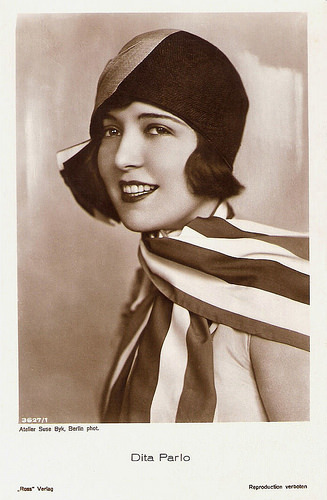
German postcard by Ross Verlag, no. 3627/1, 1928-1929. Photo: Atelier Suse Byk, Berlin.
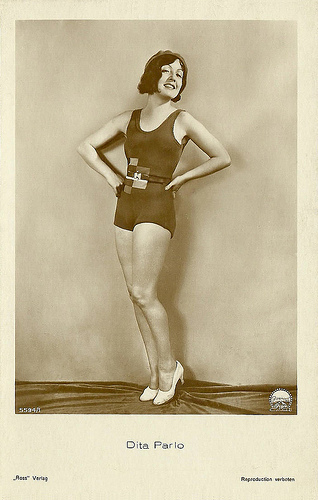
German postcard by Ross Verlag, no. 5594/1, 1930-1931. Photo: Paramount. Collection: Didier Hanson.
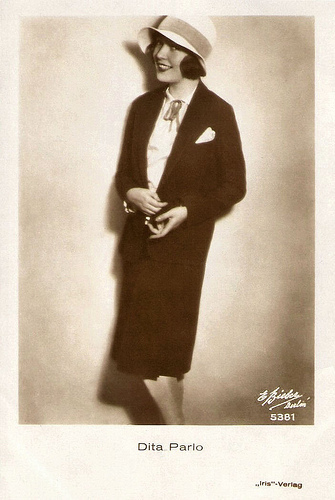
Austrian postcard by Iris Verlag, no. 5381, 1930-1931. Photo: E. Bieber, Berlin.
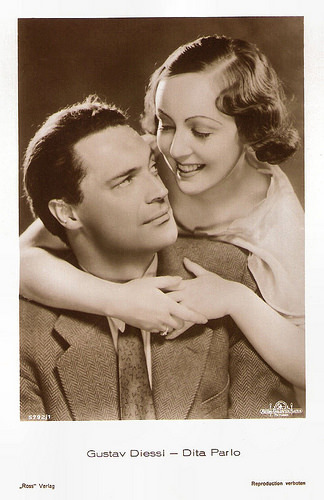
German postcard by Ross Verlag, no. 5792/1, 1930-1931. Photo: Metro-Goldwyn-Mayer. Publicity still for Menschen hinter Gittern (Pál Fejös, 1930) with http://filmstarpostcards.blogspot.nl/.... This was the German language version of The Big House (1930). Pál Fejös or Paul Fejos was a Hungarian-born, multi-lingual director, who worked at MGM at the time. He was assigned to direct both German- and French-language 'parallel versions' of The Big House, using different actors but the same costumes and sets at MGM.
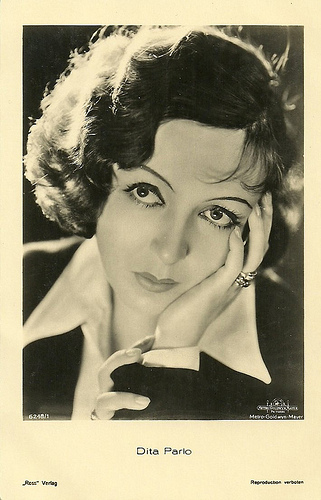
German postcard by Ross Verlag, no. 6248/1, 1931-1932. Photo: MGM.
Paris
Dita Parlo starred as a provincial bride aboard a canal barge in the beautiful L'Atalante (Jean Vigo, 1934) She and her ship captain Jean (Jean Dasté) struggle through marriage as they travel on the their barge L'Atalante along with the captain's first mate Le père Jules ( Michel Simon ) and a cabin boy. Ben Parker at IMDb : "Finally saw Vigo's L'Atalante, his only feature film, which he reportedly died before completing (Sic), and instantly its one of my top favourite movies and easily one of the best pictures ever made. L'Atalante has everything going for it: its sexy, romantic and incredibly funny. Its also immensely genuine"
Three years later Dita Parlo played a peasant opposite Jean Gabin in another masterpiece La grande illusion/The Grand Illusion (Jean Renoir, 1937). Donald J. Lamb at IMDb : "It is a wonder to see a film from the 1930's so definite in its view and opinions, yet so touching and revelatory. Jean Renoir's The Grand Illusion is a film of great importance, one that improves with each viewing."
After La grande illusion, Parlo appeared in eight more French films. She featured in the spy film Mademoiselle Docteur/Street of Shadows (G. W. Pabst, 1937). She also co-starred with Erich von Stroheim in the historical drama Ultimatum (Robert Wiene, 1938). It was the final film of Wiene, who had been a leading director of German cinema particularly noted for his work on expressionist films during the silent era. He died shortly before the film's completion, and it was finished by Robert Siodmak.
Following the outbreak of World War II, Dita Parlo was forced to return to Germany because of her nationality. That was the end of her film career. In 1949 she married a priest, Franck Gueutal. During the last thirty years of her life she worked as a writer and appeared in only three films in small parts.
She made her final film appearance as a countess who always wins at gambling in La dame de pique/The Queen of Spades (Léonard Keigel, 1965), based on the story Pikovaya dama by Alexander Pushkin. The countess had previously been given the secret that she can never reveal, and a poor Russian officer (Michel Subor) tries to force her hand with tragic results.
Dita Parlo died in 1971 in Paris. She was 65.
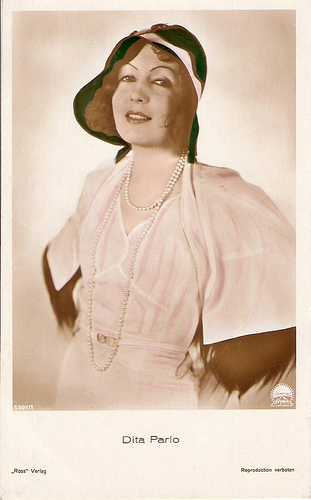
German postcard by Ross Verlag, no. 5397/1, 1930-1931. Photo: Paramount.
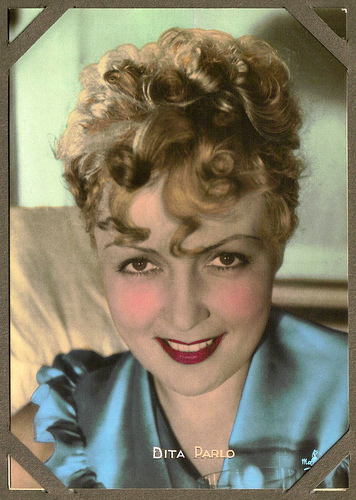
French card by Massilia. Collection: Amit Benyovits.
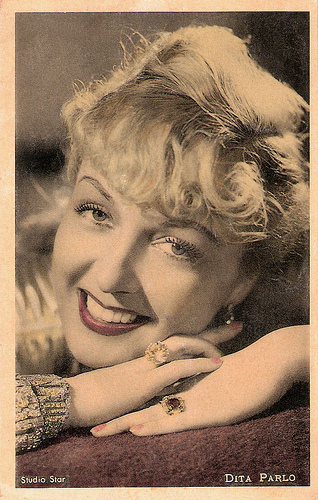
Vintage postcard. Photo: Studio Star.
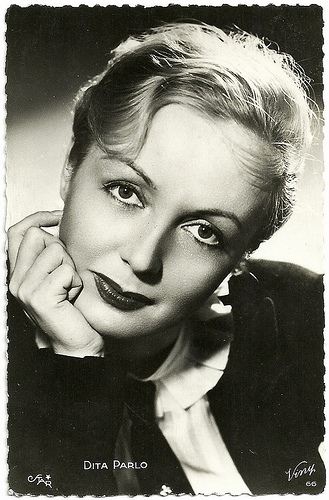
French postcard by Viny, no. 66. Photo: Star.
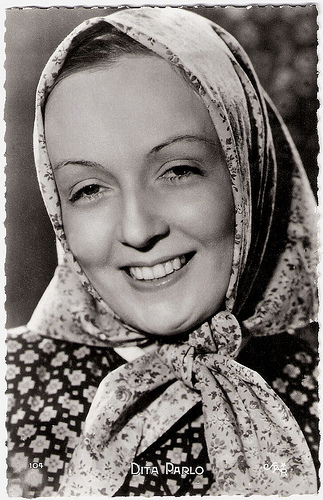
French postcard by Editions P.I., Paris, no. 104. Photo: Star. Publicity still for La Grande Illusion (Jean Renoir, 1937).
Burlesque
Dita Parlo left strong impressions on all who caught her work.
In 1992, Madonna told she was fascinated by Parlo. Madonna picked her name as an alias while touring and booking into hotels.
Madonna took her name again for the character she created for her legendary Sex book and Erotica album. Its title track commences with the line "My name is Dita, I'll be your mistress tonight... ".
Burlesque performer Dita Von Teese took her first name also in tribute to Dita Parlo.
Musician Steve Adey has a song called Dita Parlo on his studio album The Tower of Silence (2012). The song was written in response to L'Atalante.
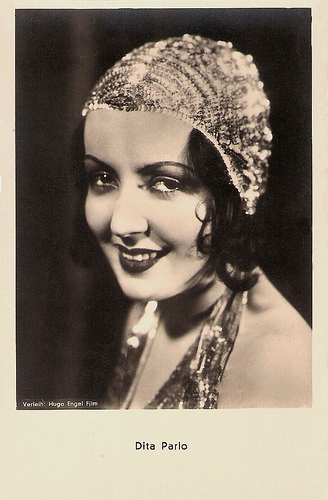
Austrian postcard by Iris-Verlag, no. 6687. Photo: Verleih Hugo Engel Film.
Trailer for L'Atalante (1934). Source: BFI Trailers (YouTube).
Trailer of La Grande Illusion (1937). Source: Danios12345 (YouTube).
Sources: Thomas Staedeli (Cyranos), Operator 99 (Allure), Sandra Brennan (AllMovie), Filmportal.de, and Wikipedia.

German postcard by Ross Verlag, no. 4591/1, 1929-1930. Photo: Atelier Badekow, Berlin.

German postcard by Ross Verlag, no. 4591/2, 1929-1930. Photo: Angelo Photos.

French postcard by Editions O.P., Paris, no. 46. Photo: Star.

French postcard. Photo: Star. Publicity still for La Grande Illusion (Jean Renoir, 1937).
Ufa Drama School
Dita Parlo was born as Gerda Olga Justina Kornstädt in Stettin, Germany (now Szczecin in Poland) in 1906 (some sources say 1908). Her father was a forest ranger.
Dita was initially trained as a ballet dancer. Subsequently she studied acting at the Babelsberg film school in Berlin. There she was discovered for the screen by producer Erich Pommer and she was signed to a contract with the Ufa studio.
She made her first film appearance as the wife of soldier Lars Hanson in the silent war drama Heimkehr/Homecoming (Joe May, 1928). After her film debut, Dita Parlo quickly rose to stardom.
Her early Ufa films include Geheimnisse des Orients/Secrets of the Orient (Alexandre Volkoff, 1928) with Nicolas Koline and Iván Petrovich , Die Dame mit der Maske/The Lady with the Mask (Wilhelm Thiele, 1928), and Ungarische Rhapsodie/Hungarian Rhapsody (Hanns Schwarz, 1928), with Willy Fritsch .
In Manolescu - Der König der Hochstapler/Manolescu (Victor Tourjansky, 1929), she appeared opposite the legendary Russian film star Ivan Mozzhukhin .

Austrian postcard by Iris-Verlag, no. 5469.

Belgian postcard by S.A. Chocolat & Cacao, Kivou, Vilvo(o)rde. Photo: Ufa.

German postcard by Ross Verlag, no. 104/3. Photo: Ufa. Publicity still for Ungarische Rhapsodie/Hungarian Rhapsody (Hanns Schwarz, 1928) with Willy Fritsch .

Polish postcard by Polonia, Krakow, no. 882. Photo: Ufa

Polish postcard by Polonia, Krakow, no. 1641. Photo: Ufa.
Hollywood
Dita Parlo appeared in the first sound film of the Ufa, Melodie des Herzens/Melody of the Heart (Hanns Schwarz, 1929) opposite Willy Fritsch .
In France she also became popular, and appeared in Au bonheur des dames/For the Happiness of Women (Julien Duvivier, 1930), an adaptation of Emile Zola's 1883 novel of the same name.
In 1931 she tried her luck in Hollywood. She often appeared in German-speaking versions of American films and she played parts in the minor films Honor of the Family (Lloyd Bacon, 1931) with Bebe Daniels, and the comedy anthology Mr. Broadway (Johnnie Walker, 1933). The sketch with Parlo in the latter film was taken from an uncompleted film by Edgar G. Ulmer, titled Love's Interlude. This film was begun in 1932 at Peerless Productions.
After two years in Hollywood and no success, Dita Parlo moved to Paris. She married a Frenchman, and would make only French films for the rest of her career.
Later she was scheduled to appear in the proposed Orson Welles production of Joseph Conrad's Heart of Darkness for RKO Radio Pictures. However, that project did not come to pass, and Welles began work on Citizen Kane.

German postcard by Ross Verlag, no. 3627/1, 1928-1929. Photo: Atelier Suse Byk, Berlin.

German postcard by Ross Verlag, no. 5594/1, 1930-1931. Photo: Paramount. Collection: Didier Hanson.

Austrian postcard by Iris Verlag, no. 5381, 1930-1931. Photo: E. Bieber, Berlin.

German postcard by Ross Verlag, no. 5792/1, 1930-1931. Photo: Metro-Goldwyn-Mayer. Publicity still for Menschen hinter Gittern (Pál Fejös, 1930) with http://filmstarpostcards.blogspot.nl/.... This was the German language version of The Big House (1930). Pál Fejös or Paul Fejos was a Hungarian-born, multi-lingual director, who worked at MGM at the time. He was assigned to direct both German- and French-language 'parallel versions' of The Big House, using different actors but the same costumes and sets at MGM.

German postcard by Ross Verlag, no. 6248/1, 1931-1932. Photo: MGM.
Paris
Dita Parlo starred as a provincial bride aboard a canal barge in the beautiful L'Atalante (Jean Vigo, 1934) She and her ship captain Jean (Jean Dasté) struggle through marriage as they travel on the their barge L'Atalante along with the captain's first mate Le père Jules ( Michel Simon ) and a cabin boy. Ben Parker at IMDb : "Finally saw Vigo's L'Atalante, his only feature film, which he reportedly died before completing (Sic), and instantly its one of my top favourite movies and easily one of the best pictures ever made. L'Atalante has everything going for it: its sexy, romantic and incredibly funny. Its also immensely genuine"
Three years later Dita Parlo played a peasant opposite Jean Gabin in another masterpiece La grande illusion/The Grand Illusion (Jean Renoir, 1937). Donald J. Lamb at IMDb : "It is a wonder to see a film from the 1930's so definite in its view and opinions, yet so touching and revelatory. Jean Renoir's The Grand Illusion is a film of great importance, one that improves with each viewing."
After La grande illusion, Parlo appeared in eight more French films. She featured in the spy film Mademoiselle Docteur/Street of Shadows (G. W. Pabst, 1937). She also co-starred with Erich von Stroheim in the historical drama Ultimatum (Robert Wiene, 1938). It was the final film of Wiene, who had been a leading director of German cinema particularly noted for his work on expressionist films during the silent era. He died shortly before the film's completion, and it was finished by Robert Siodmak.
Following the outbreak of World War II, Dita Parlo was forced to return to Germany because of her nationality. That was the end of her film career. In 1949 she married a priest, Franck Gueutal. During the last thirty years of her life she worked as a writer and appeared in only three films in small parts.
She made her final film appearance as a countess who always wins at gambling in La dame de pique/The Queen of Spades (Léonard Keigel, 1965), based on the story Pikovaya dama by Alexander Pushkin. The countess had previously been given the secret that she can never reveal, and a poor Russian officer (Michel Subor) tries to force her hand with tragic results.
Dita Parlo died in 1971 in Paris. She was 65.

German postcard by Ross Verlag, no. 5397/1, 1930-1931. Photo: Paramount.

French card by Massilia. Collection: Amit Benyovits.

Vintage postcard. Photo: Studio Star.

French postcard by Viny, no. 66. Photo: Star.

French postcard by Editions P.I., Paris, no. 104. Photo: Star. Publicity still for La Grande Illusion (Jean Renoir, 1937).
Burlesque
Dita Parlo left strong impressions on all who caught her work.
In 1992, Madonna told she was fascinated by Parlo. Madonna picked her name as an alias while touring and booking into hotels.
Madonna took her name again for the character she created for her legendary Sex book and Erotica album. Its title track commences with the line "My name is Dita, I'll be your mistress tonight... ".
Burlesque performer Dita Von Teese took her first name also in tribute to Dita Parlo.
Musician Steve Adey has a song called Dita Parlo on his studio album The Tower of Silence (2012). The song was written in response to L'Atalante.

Austrian postcard by Iris-Verlag, no. 6687. Photo: Verleih Hugo Engel Film.
Trailer for L'Atalante (1934). Source: BFI Trailers (YouTube).
Trailer of La Grande Illusion (1937). Source: Danios12345 (YouTube).
Sources: Thomas Staedeli (Cyranos), Operator 99 (Allure), Sandra Brennan (AllMovie), Filmportal.de, and Wikipedia.
Published on February 20, 2016 22:00
February 19, 2016
Simone Signoret
French actress Simone Signoret (1921-1985) was given the ‘star build-up’ in the postwar years, and in the following decades she developed into one of the grand legends of the French cinema. Signoret won three times a BAFTA Award, an Oscar, an Emmy, a Silver Bear at the Berlin Festival, a Golden Palm at the Cannes Festival, and many, many more awards.
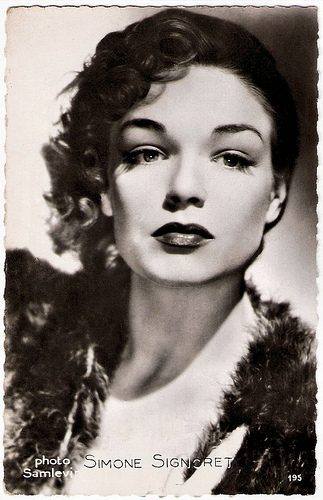
French postcard by Editions P.I., Paris, no. 195. Publicity card for Les carbones Korès. Photo: Sam Lévin.
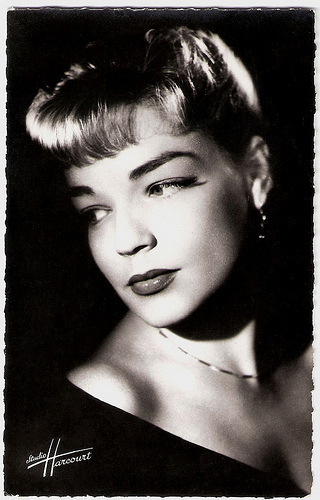
French postcard by Editions du Globe, Paris. Photo: Studio Harcourt.
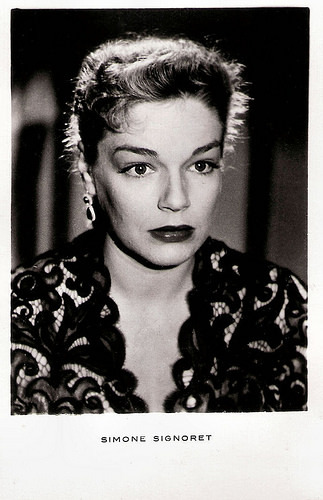
Vintage postcard. Photo: publicity still for Ombre et lumière/Shadow and Light (Henri Calef, 1951).
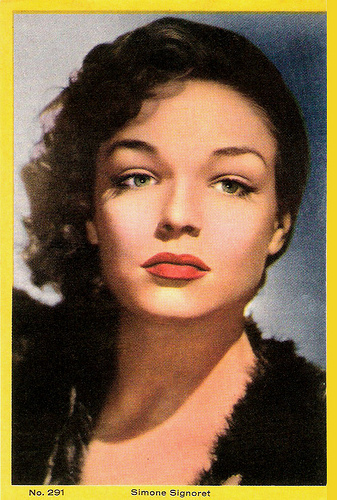
Mexican postcard, no. 291. Photo: Sam Lévin.
Unlucky-in-love
Simone Signoret was born Simone Henriette Charlotte Kaminker in Wiesbaden, Germany, in 1921. Her father, André Kaminker, a pioneering interpreter who worked in the League of Nations, was a French-born Jewish army officer of Polish descent, who brought the family to Neuilly-sur-Seine on the outskirts of Paris. He and his French wife Georgette Kaminker-Signoret, had also two younger sons, Alain and Jean-Pierre.
Simone grew up in Paris in an intellectual atmosphere and studied the English language in school, earning a teaching certificate. She tutored English and Latin and worked part-time as a typist for a French collaborationist newspaper, Les nouveaux temps, run by Jean Luchaire.
During the German occupation of France, Signoret mixed with an artistic group of writers and actors who met at a café in the Saint-Germain-des-Prés quarter, Café de Flore. By this time, she had developed an interest in acting and was encouraged by her friends, including her lover, Daniel Gélin , to follow her ambition.
In 1942, she began appearing in bit parts, making her film debut in Le Prince charmant/Prince Charming (Jean Boyer, 1942). She was working without an official permit during the Nazi occupation of France, because her patriotic father, who had fled to England in 1940 to join General De Gaulle there, was Jewish.
Working almost all the time, she was able to earn enough money to support her mother and two brothers. For the cinema she took her mother's maiden name, Signoret, to help hide her Jewish roots for the Nazi authorities. She had a long film apprenticeship during World War II, mostly as an extra and occasionally getting to speak a single line.
Through the auspices of her first husband, director Yves Allégret, Signoret was given the ‘star build-up’ in the postwar years. Her husband directed her in Dédée d'Anvers/Woman of Antwerp (Yves Allégret, 1948), as Dédée, a prostitute who finds true love. In 1949 she left her husband for actor-singer Yves Montand , whom she married in 1951 and with whom she lived until her death.
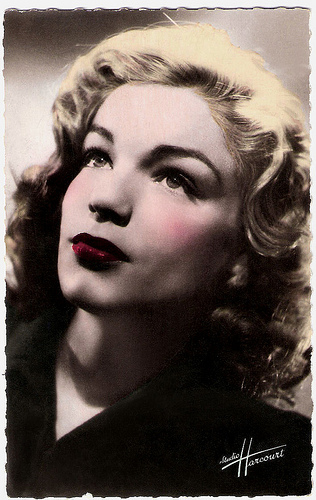
French postcard by Editions O.P., no. 19. Photo: Studio Harcourt.
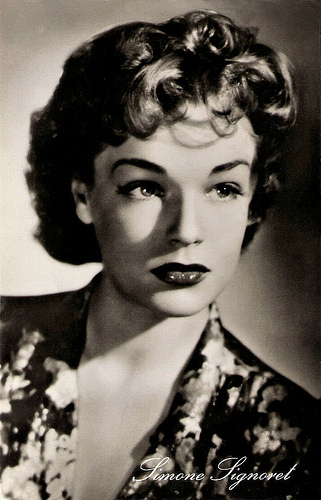
German postcard by VEB Progress Film-Vertrieb, Berlin, no. 820.
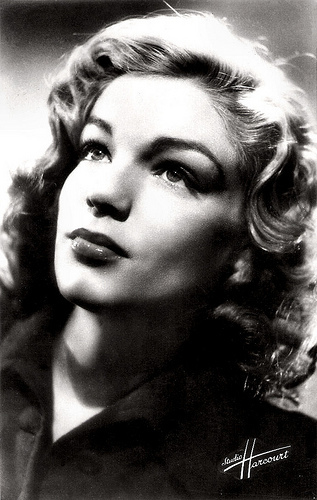
French postcard by Editions O.P., Paris, no. 19. Photo: Studio Harcourt.
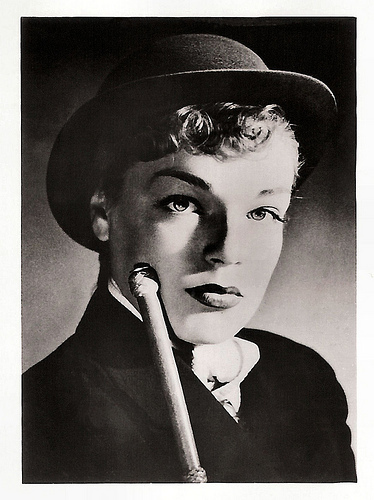
German collectors card by Greiling Sammelbilder in the series Filmstars der Welt, 2. Band, Serie E, no. 97. Photo: Allianz Film. Publicity still for Manèges/The Cheat (Yves Allégret, 1950).
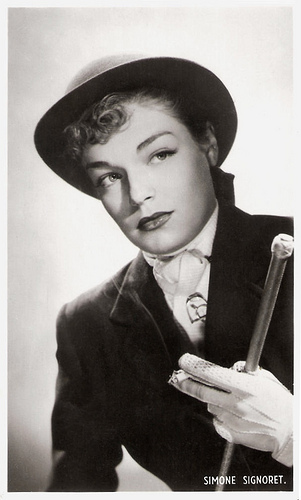
Vintage collectors card, no. A 55. Photo: publicity still for Manèges/The Cheat (Yves Allégret, 1950).
Yves Montand
"The young Simone Signoret radiated beauty and a ripe sensuality which glowed tangibly from the screen", writes Philip Kemp at Film Reference : "She moved with the indolent languor of a woman supremely confident in her own powers of attraction; the slow, sleepy smile and the heavy-lidded eyes irresistibly evoked thoughts of warm bedrooms and summer meadows. Inevitably, she was cast time and again as a prostitute, a profession amply represented in the postwar French cinema."
An example is her role opposite Gérard Philipe in La Ronde/Round (Max Ophüls, 1950), a film which was banned briefly in New York as immoral. One of the best of her unlucky-in-love characterizations was as the title figure in Casque d'or/Golden Helmet (Jacques Becker, 1952), for which she won a BAFTA Film Award.
Other notable French films in which Signoret appeared during the 1950s are the Emile Zola adaptation Thérèse Raquin/The Adultress (Marcel Carné, 1953) with Raf Vallone , Le mort en ce jardin/Death in the Garden (Luis Buñuel, 1956) with Charles Vanel , and Les Sorcières de Salem/The Witches of Salem (Raymond Rouleau, 1956) based on Arthur Miller's play.
A Signoret film that is shown often on TV is the thriller Les diaboliques/Diabolique (Henri-Georges Clouzot, 1955) with Véra Clouzot and Paul Meurisse . The chilly character Signoret plays was proof of her immense acting ability.
Philip Kemp at Film Reference : "As a murderess, she could be both credible and sympathetic: as one of Zola's pair of guilt-ridden lovers in Thérèse Raquin, or as the seemingly vulnerable yet scheming blond bomb-shell accomplice in the homicidal labyrinth of Clouzot's Les Diaboliques, the role that cemented her international renown and became an archetype thereafter in imitation upon ripoff of the Boileau-Narcejac thriller, including three remakes with Tuesday Weld, Kate Vernon, and, most recently, Sharon Stone filling Signoret's shoes."
Hollywood beckoned throughout the 1950s, but both Signoret and Yves Montand , were refused visas to enter the United States. Their progressive political activities did not sit well with the McCarthy-era mentality in the US at the time.
Her breakthrough to international stardom came at the age of 38 with the British film Room at the Top (Jack Clayton, 1959) opposite Laurence Harvey . She won an Academy Award for her portrayal of Alice Aisgill, an unhappily married woman who hopes she has found true love. She radiated real warmth in all of her scenes.
Later she played in England again opposite Laurence Olivier in Term of Trial (Peter Glenville, 1962), and in America with Vivien Leigh in Ship of Fools (Stanley Kramer, 1965), which earned her another Oscar nomination.
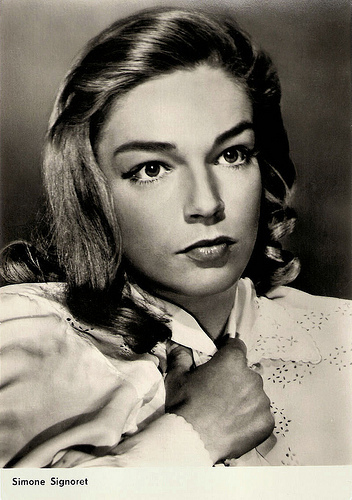
East-German postcard by VEB Progress Film-Vertrieb, no. 1924. Photo: publicity still for Thérèse Raquin/The Adultress (Marcel Carné, 1953).
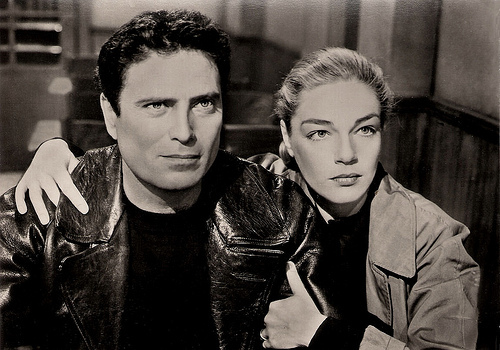
East-German postcard by VEB Progress Film-Vertrieb, Berlin, no. 1925. Retail price: 0,20 DM. Photo: publicity still for Thérèse Raquin/The Adultress (Marcel Carné, 1953) with Raf Vallone.
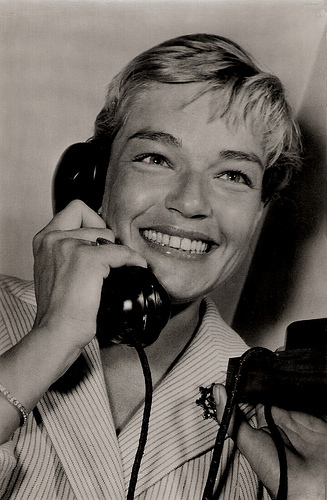
East-German postcard by VEB Progress Film-Vertrieb, Berlin, no. 147. Photo: Gerhard Puhlmann. Simone Signoret then played in the coproduction of Films Borderie, Paris, and DEFA, Berlin, Les sorcières de Salem/The Witches of Salem (Raymond Rouleau, 1956).
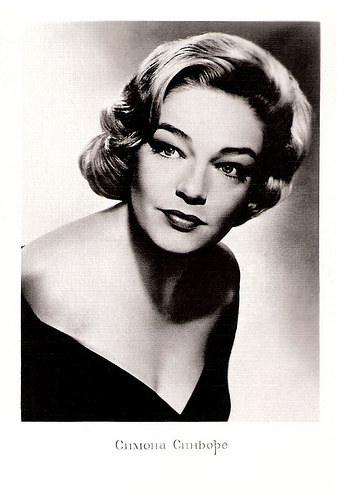
Russian postcard, 1961. Retail price: 8 Kop.
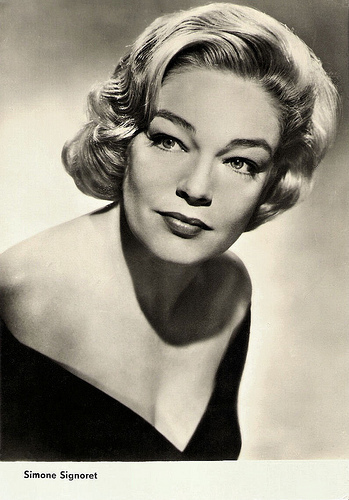
East-German postcard by VEB Progress Film-Vertrieb, Berlin, no. 1412.
Plump but still Bewitching
Through the years, Simone Signoret matured into a plump but still bewitching character actress. She was never concerned with glamour, ignored the insults about her gaining weight and letting her looks go, and continued giving finely etched performances.
Her later films include the thriller Compartiment tueurs/The Sleeping Car Murders (Costa Gravas, 1965), the war drama L'armée des ombres/Army of the Shadows (Jean-Pierre Melville, 1969) with Lino Ventura , and the crime drama La chair de l'orchidée/The Flesh of the Orchid (Patrice Chéreau, 1975) starring Charlotte Rampling .
In La vie devant soi/Madame Rosa (Moshe Mizrahi, 1977) she played a Jewish, retired prostitute and Auschwitz survivor, who is now a foster mom to children of other prostitutes in Paris' Arab community. This beautiful drama was awarded with the Academy Award for the Best Non-English Film.
Her final film was L'étoile du Nord/The North Star (Pierre Granier-Deferre, 1982) a thriller about a mysterious psychopath with Michel Piccoli . Simone Signoret also wrote books, such as the witty, melancholy memoir La nostalgie n'est plus ce qu'elle était/Nostalgia Isn't What It Used To Be (1978) and Adieu Volodya/Adieu Volodia, a novel about a group of Jewish immigrants from Ukraine and Russia and their children, working in the theatre and film industry in Paris during the years 1926-1945. This novel was published in 1985, the year of her death.
A lifelong chain smoker, Simone Signoret died of pancreatic cancer in Auteuil-Anthouillet, France. Her daughter, Catherine Allégret, and grandson, Benjamin Castaldi, are also actors. At Films de France , James Travers concludes his bio thus: "Today, Simone Signoret is fondly remembered as one of French cinema’s most talented performers, a generous and greatly loved individual whose incisive portrayals of complex women showed not just the allure of her sex, but also that resilience and generosity of spirit that is uniquely feminine".
Opening scene from La Ronde/Round (1950). Source: classicmovieslibrary (You Tube).
Trailer for Les diaboliques/Diabolique (1955). Source: The Criterion Collection (You Tube).
Trailer for L'armée des ombres/Army of the Shadows (1969). Source: Movies Trailers (You Tube).
Sources: James Travers (Films de France), Philip Kemp (Film Reference), Hal Erickson (AllMovie), (IMDb), and Wikipedia.

French postcard by Editions P.I., Paris, no. 195. Publicity card for Les carbones Korès. Photo: Sam Lévin.

French postcard by Editions du Globe, Paris. Photo: Studio Harcourt.

Vintage postcard. Photo: publicity still for Ombre et lumière/Shadow and Light (Henri Calef, 1951).

Mexican postcard, no. 291. Photo: Sam Lévin.
Unlucky-in-love
Simone Signoret was born Simone Henriette Charlotte Kaminker in Wiesbaden, Germany, in 1921. Her father, André Kaminker, a pioneering interpreter who worked in the League of Nations, was a French-born Jewish army officer of Polish descent, who brought the family to Neuilly-sur-Seine on the outskirts of Paris. He and his French wife Georgette Kaminker-Signoret, had also two younger sons, Alain and Jean-Pierre.
Simone grew up in Paris in an intellectual atmosphere and studied the English language in school, earning a teaching certificate. She tutored English and Latin and worked part-time as a typist for a French collaborationist newspaper, Les nouveaux temps, run by Jean Luchaire.
During the German occupation of France, Signoret mixed with an artistic group of writers and actors who met at a café in the Saint-Germain-des-Prés quarter, Café de Flore. By this time, she had developed an interest in acting and was encouraged by her friends, including her lover, Daniel Gélin , to follow her ambition.
In 1942, she began appearing in bit parts, making her film debut in Le Prince charmant/Prince Charming (Jean Boyer, 1942). She was working without an official permit during the Nazi occupation of France, because her patriotic father, who had fled to England in 1940 to join General De Gaulle there, was Jewish.
Working almost all the time, she was able to earn enough money to support her mother and two brothers. For the cinema she took her mother's maiden name, Signoret, to help hide her Jewish roots for the Nazi authorities. She had a long film apprenticeship during World War II, mostly as an extra and occasionally getting to speak a single line.
Through the auspices of her first husband, director Yves Allégret, Signoret was given the ‘star build-up’ in the postwar years. Her husband directed her in Dédée d'Anvers/Woman of Antwerp (Yves Allégret, 1948), as Dédée, a prostitute who finds true love. In 1949 she left her husband for actor-singer Yves Montand , whom she married in 1951 and with whom she lived until her death.

French postcard by Editions O.P., no. 19. Photo: Studio Harcourt.

German postcard by VEB Progress Film-Vertrieb, Berlin, no. 820.

French postcard by Editions O.P., Paris, no. 19. Photo: Studio Harcourt.

German collectors card by Greiling Sammelbilder in the series Filmstars der Welt, 2. Band, Serie E, no. 97. Photo: Allianz Film. Publicity still for Manèges/The Cheat (Yves Allégret, 1950).

Vintage collectors card, no. A 55. Photo: publicity still for Manèges/The Cheat (Yves Allégret, 1950).
Yves Montand
"The young Simone Signoret radiated beauty and a ripe sensuality which glowed tangibly from the screen", writes Philip Kemp at Film Reference : "She moved with the indolent languor of a woman supremely confident in her own powers of attraction; the slow, sleepy smile and the heavy-lidded eyes irresistibly evoked thoughts of warm bedrooms and summer meadows. Inevitably, she was cast time and again as a prostitute, a profession amply represented in the postwar French cinema."
An example is her role opposite Gérard Philipe in La Ronde/Round (Max Ophüls, 1950), a film which was banned briefly in New York as immoral. One of the best of her unlucky-in-love characterizations was as the title figure in Casque d'or/Golden Helmet (Jacques Becker, 1952), for which she won a BAFTA Film Award.
Other notable French films in which Signoret appeared during the 1950s are the Emile Zola adaptation Thérèse Raquin/The Adultress (Marcel Carné, 1953) with Raf Vallone , Le mort en ce jardin/Death in the Garden (Luis Buñuel, 1956) with Charles Vanel , and Les Sorcières de Salem/The Witches of Salem (Raymond Rouleau, 1956) based on Arthur Miller's play.
A Signoret film that is shown often on TV is the thriller Les diaboliques/Diabolique (Henri-Georges Clouzot, 1955) with Véra Clouzot and Paul Meurisse . The chilly character Signoret plays was proof of her immense acting ability.
Philip Kemp at Film Reference : "As a murderess, she could be both credible and sympathetic: as one of Zola's pair of guilt-ridden lovers in Thérèse Raquin, or as the seemingly vulnerable yet scheming blond bomb-shell accomplice in the homicidal labyrinth of Clouzot's Les Diaboliques, the role that cemented her international renown and became an archetype thereafter in imitation upon ripoff of the Boileau-Narcejac thriller, including three remakes with Tuesday Weld, Kate Vernon, and, most recently, Sharon Stone filling Signoret's shoes."
Hollywood beckoned throughout the 1950s, but both Signoret and Yves Montand , were refused visas to enter the United States. Their progressive political activities did not sit well with the McCarthy-era mentality in the US at the time.
Her breakthrough to international stardom came at the age of 38 with the British film Room at the Top (Jack Clayton, 1959) opposite Laurence Harvey . She won an Academy Award for her portrayal of Alice Aisgill, an unhappily married woman who hopes she has found true love. She radiated real warmth in all of her scenes.
Later she played in England again opposite Laurence Olivier in Term of Trial (Peter Glenville, 1962), and in America with Vivien Leigh in Ship of Fools (Stanley Kramer, 1965), which earned her another Oscar nomination.

East-German postcard by VEB Progress Film-Vertrieb, no. 1924. Photo: publicity still for Thérèse Raquin/The Adultress (Marcel Carné, 1953).

East-German postcard by VEB Progress Film-Vertrieb, Berlin, no. 1925. Retail price: 0,20 DM. Photo: publicity still for Thérèse Raquin/The Adultress (Marcel Carné, 1953) with Raf Vallone.

East-German postcard by VEB Progress Film-Vertrieb, Berlin, no. 147. Photo: Gerhard Puhlmann. Simone Signoret then played in the coproduction of Films Borderie, Paris, and DEFA, Berlin, Les sorcières de Salem/The Witches of Salem (Raymond Rouleau, 1956).

Russian postcard, 1961. Retail price: 8 Kop.

East-German postcard by VEB Progress Film-Vertrieb, Berlin, no. 1412.
Plump but still Bewitching
Through the years, Simone Signoret matured into a plump but still bewitching character actress. She was never concerned with glamour, ignored the insults about her gaining weight and letting her looks go, and continued giving finely etched performances.
Her later films include the thriller Compartiment tueurs/The Sleeping Car Murders (Costa Gravas, 1965), the war drama L'armée des ombres/Army of the Shadows (Jean-Pierre Melville, 1969) with Lino Ventura , and the crime drama La chair de l'orchidée/The Flesh of the Orchid (Patrice Chéreau, 1975) starring Charlotte Rampling .
In La vie devant soi/Madame Rosa (Moshe Mizrahi, 1977) she played a Jewish, retired prostitute and Auschwitz survivor, who is now a foster mom to children of other prostitutes in Paris' Arab community. This beautiful drama was awarded with the Academy Award for the Best Non-English Film.
Her final film was L'étoile du Nord/The North Star (Pierre Granier-Deferre, 1982) a thriller about a mysterious psychopath with Michel Piccoli . Simone Signoret also wrote books, such as the witty, melancholy memoir La nostalgie n'est plus ce qu'elle était/Nostalgia Isn't What It Used To Be (1978) and Adieu Volodya/Adieu Volodia, a novel about a group of Jewish immigrants from Ukraine and Russia and their children, working in the theatre and film industry in Paris during the years 1926-1945. This novel was published in 1985, the year of her death.
A lifelong chain smoker, Simone Signoret died of pancreatic cancer in Auteuil-Anthouillet, France. Her daughter, Catherine Allégret, and grandson, Benjamin Castaldi, are also actors. At Films de France , James Travers concludes his bio thus: "Today, Simone Signoret is fondly remembered as one of French cinema’s most talented performers, a generous and greatly loved individual whose incisive portrayals of complex women showed not just the allure of her sex, but also that resilience and generosity of spirit that is uniquely feminine".
Opening scene from La Ronde/Round (1950). Source: classicmovieslibrary (You Tube).
Trailer for Les diaboliques/Diabolique (1955). Source: The Criterion Collection (You Tube).
Trailer for L'armée des ombres/Army of the Shadows (1969). Source: Movies Trailers (You Tube).
Sources: James Travers (Films de France), Philip Kemp (Film Reference), Hal Erickson (AllMovie), (IMDb), and Wikipedia.
Published on February 19, 2016 22:00
February 18, 2016
EFSP's Dazzling Dozen: Sword and Sandal epics
One of the most popular European film genres of the 1950s and 1960s was the Peplum, also known as the Sword-and-Sandal epics. They were mostly produced in Italy, but the heroes were international: British, French, Dutch (!), Italian and American. The Peplum craze started in 1957, when bodybuilder Steve Reeves was invited to come to Cinécitta and play the lead character in Le fatiche di Ercole/Hercules (Pietro Francisci, 1958), opposite the gorgeous Sylva Koscina. But Italy had a long tradition of film epics about ancient Rome.
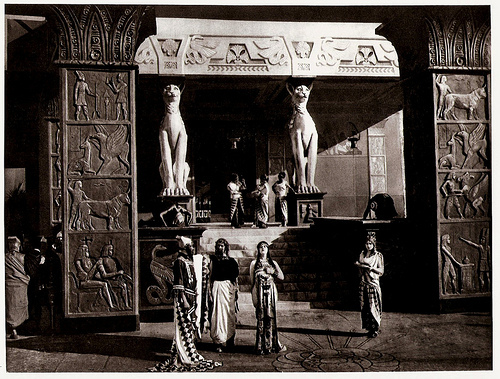
Publicity still of the Italian silent film classic Cabiria (Giovanni Pastrone, 1914). The first of the biblical epics. The genre became very popular in the international cinema of the 1910s.
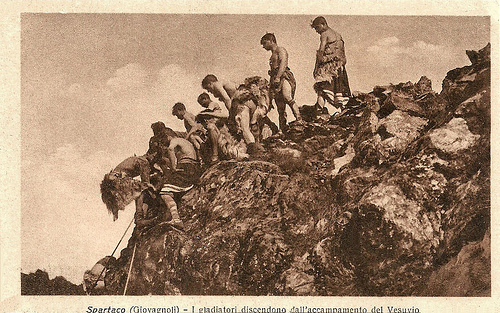
Italian postcard.
Mario Guaita aka Ausonia (1881-1956) was an Italian actor, director, producer and scriptwriter in the silent era. He had his international breakthrough with Spartaco - Il gladiatore della Tracia/Spartacus (Enrico Vidali 1913). Caption: I gladiatori discendono dall'accampamento del Vesuvio (The gladiators descend from their camps at Mount Vesuvius). Led by Spartacus, they will conquer Crassus' army and capture the consul.
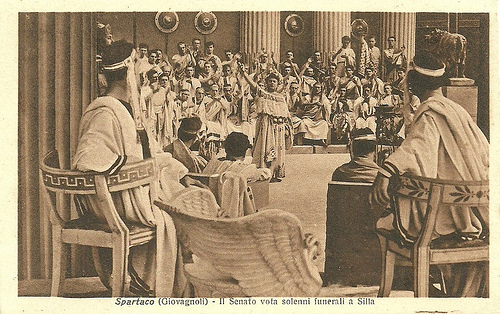
Italian postcard for the Italian epic Spartaco - Il gladiatore della Tracia (Enrico Vidali, Pasquali 1913), starring Mario Guaita - Ausonia . The film was based on a novel by Raffaello Giovagnoli. Caption: Il Senato vota solenni funerali a Silla (The Senate votes to hold a solemn funeral for Silla).
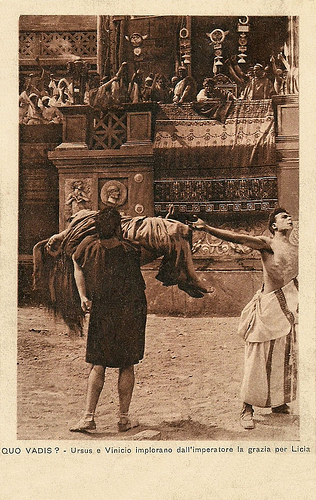
Italian postcard by Uff. Rev. St. Terni. Photo: publicity still for Quo Vadis? (Enrico Guazzoni, 1913).
Ursus ( Bruto Castellani ) and Vinicius ( Amleto Novelli ) implore the audience and emperor Nero to grace the Christian Lygia ( Lea Giunchi ), after Ursus has killed the bull on which back Lygia had been bound. The audience raves because of Ursus' tour de force. Vinicius has stripped his cloth to show his scars from the wars, while Ursus holds up Lygia. All around Nero hold their thumbs up for grace, even if this sign seems to have been a 19th century invention and historically incorrect.
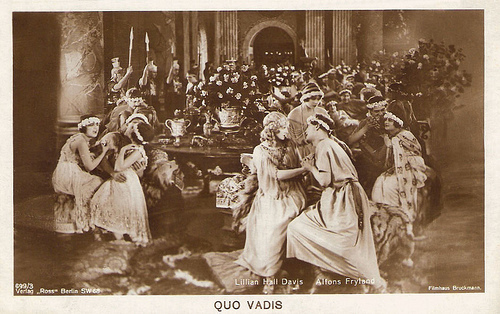
German postcard by Ross Verlag, no. 699/3, 1919-1924. Photo: Filmhaus Bruckmann.
Publicity still for Quo vadis? (Georg Jacoby, Gabriellino D'Annunzio, 1924) with Alphons Fryland (Vinicius) and Lilian Hall-Davis (Lygia) in an adaptation of Henryk Sienkiewicz classic novel on the Rome of Nero. Here Vinicius tries to seduce the chaste Lygia during an orgy at the palace of Nero.
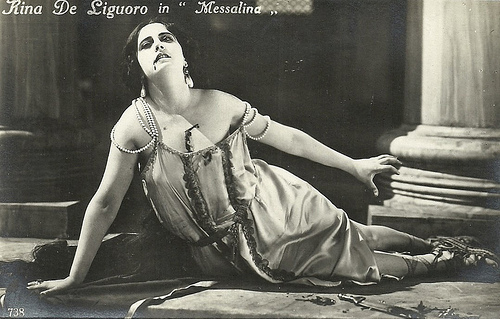
Italian postcard by Ed. A. Traldi, Milano, no. 738.
Rina De Liguoro dying in the final scene of Messalina (Enrico Guazzoni, 1924). The film was her breakthrough and De Liguoro became the last diva of the Italian silent cinema with notable films like Quo vadis? (Gabriellino D'Annunzio, Georg Jacoby, 1924), and Gli ultimi giorni di Pompeii/The Last Days of Pompeii (Carmine Gallone, Amleto Palermi, 1926).
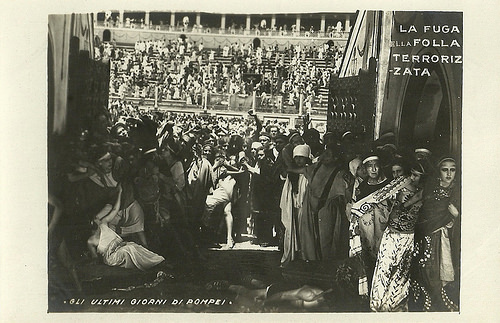
Italian postcard by C. Chierichetti, Milano. Photo: Grandi Films, Roma.
Postcard for the Italian-German silent film Gli ultimi giorni di Pompei/The Last Days of Pompeii (Amleto Palermi, Carmine Gallone, 1926). The film was one of the many adaptations of the novel The Last Days of Pompeii (1834) by Edward George Bulwer-Lytton.

Italian postcard by C. Chierichetti, Milano. Photo: Grandi Films, Roma.
Another postcard for the Italian-German silent film Gli ultimi giorni di Pompei/The Last Days of Pompeii (Amleto Palermi, Carmine Gallone, 1926), starring the Hungarian actor Victor Varconi (1891–1976). He was a highly successful matinee idol of the Hungarian-Austrian and German silent cinema in the 1910s and early 1920s. Later he was the first Hungarian actor to become a Hollywood star until the sound film completely altered the course of his career.
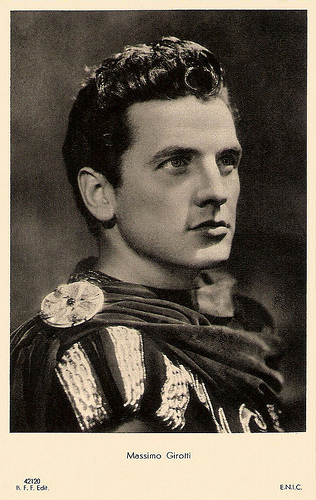
Italian postcard by B.F.F. Edit., no. 42120. Photo: E.N.I.C.
Publicity still of Massimo Girotti in La corona di ferro/The Iron Crown (Alessandro Blasetti, 1941). Blasetti gave new life to the Italian treatment of heroic mythology born in the silent era with Pastrone's Cabiria, and La corona di ferro is an important antecedents to the postwar genre of the Peplum.
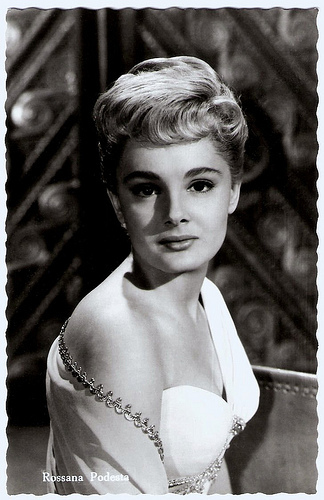
Dutch postcard by Editions P.I., no. 662.
Publicity still for Helen of Troy (1956). Italian sex siren Rossana Podestà (1934) played in many European films of the 1950s and 1960s. She is best known as the stunningly beautiful leading lady of the international spectacle Helen of Troy (Robert Wise, 1956).
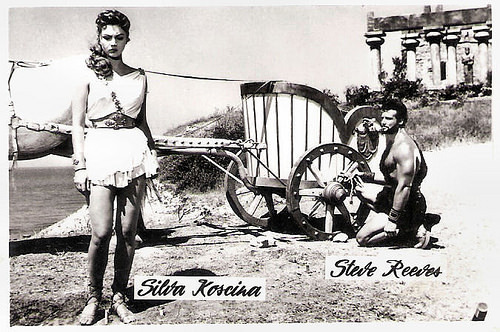
Small Romanian collectors card. Photo: publicity still for Ercole e la regina di Lidia/Hercules Unchained (Pietro Francisci, 1959) with Steve Reeves and Sylva Koscina .
Handsome, musclebound Steve Reeves (1926-2000) was an American bodybuilder and actor, who was a huge success in Hercules (1958) and other Peplum films, the Italian sword-and-sandal epics. At the peak of his career, around 1960, he was reputedly the highest-paid actor in Europe.
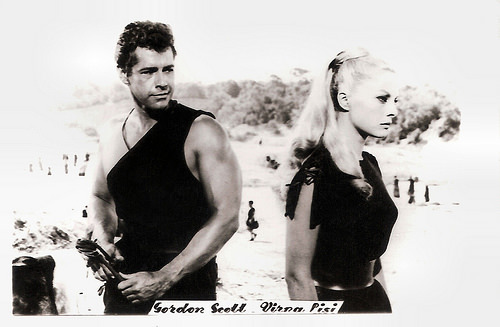
Small Romanian collectors card. Photo: publicity still for Romolo e Remo/Duel of the Titans (Sergio Corbucci, 1961) with Gordon Scott and Virna Lisi .
Good-looking and muscular American actor Gordon Scott (1926–2007) is best known as the eleventh Tarzan. He portrayed Tarzan in five films from 1955 to 1960. Then Scott moved to Italy, where he became a popular star of the Peplum film genre, the sword-and-sandal epics. When the Peplum faded, Scott starred in Spaghetti Westerns and Eurospy films.
This is a post for Postcard Friendship Friday, hosted by Beth at the The Best Hearts are Crunchy. You can visit her by clicking on the button below.


Publicity still of the Italian silent film classic Cabiria (Giovanni Pastrone, 1914). The first of the biblical epics. The genre became very popular in the international cinema of the 1910s.

Italian postcard.
Mario Guaita aka Ausonia (1881-1956) was an Italian actor, director, producer and scriptwriter in the silent era. He had his international breakthrough with Spartaco - Il gladiatore della Tracia/Spartacus (Enrico Vidali 1913). Caption: I gladiatori discendono dall'accampamento del Vesuvio (The gladiators descend from their camps at Mount Vesuvius). Led by Spartacus, they will conquer Crassus' army and capture the consul.

Italian postcard for the Italian epic Spartaco - Il gladiatore della Tracia (Enrico Vidali, Pasquali 1913), starring Mario Guaita - Ausonia . The film was based on a novel by Raffaello Giovagnoli. Caption: Il Senato vota solenni funerali a Silla (The Senate votes to hold a solemn funeral for Silla).

Italian postcard by Uff. Rev. St. Terni. Photo: publicity still for Quo Vadis? (Enrico Guazzoni, 1913).
Ursus ( Bruto Castellani ) and Vinicius ( Amleto Novelli ) implore the audience and emperor Nero to grace the Christian Lygia ( Lea Giunchi ), after Ursus has killed the bull on which back Lygia had been bound. The audience raves because of Ursus' tour de force. Vinicius has stripped his cloth to show his scars from the wars, while Ursus holds up Lygia. All around Nero hold their thumbs up for grace, even if this sign seems to have been a 19th century invention and historically incorrect.

German postcard by Ross Verlag, no. 699/3, 1919-1924. Photo: Filmhaus Bruckmann.
Publicity still for Quo vadis? (Georg Jacoby, Gabriellino D'Annunzio, 1924) with Alphons Fryland (Vinicius) and Lilian Hall-Davis (Lygia) in an adaptation of Henryk Sienkiewicz classic novel on the Rome of Nero. Here Vinicius tries to seduce the chaste Lygia during an orgy at the palace of Nero.

Italian postcard by Ed. A. Traldi, Milano, no. 738.
Rina De Liguoro dying in the final scene of Messalina (Enrico Guazzoni, 1924). The film was her breakthrough and De Liguoro became the last diva of the Italian silent cinema with notable films like Quo vadis? (Gabriellino D'Annunzio, Georg Jacoby, 1924), and Gli ultimi giorni di Pompeii/The Last Days of Pompeii (Carmine Gallone, Amleto Palermi, 1926).

Italian postcard by C. Chierichetti, Milano. Photo: Grandi Films, Roma.
Postcard for the Italian-German silent film Gli ultimi giorni di Pompei/The Last Days of Pompeii (Amleto Palermi, Carmine Gallone, 1926). The film was one of the many adaptations of the novel The Last Days of Pompeii (1834) by Edward George Bulwer-Lytton.

Italian postcard by C. Chierichetti, Milano. Photo: Grandi Films, Roma.
Another postcard for the Italian-German silent film Gli ultimi giorni di Pompei/The Last Days of Pompeii (Amleto Palermi, Carmine Gallone, 1926), starring the Hungarian actor Victor Varconi (1891–1976). He was a highly successful matinee idol of the Hungarian-Austrian and German silent cinema in the 1910s and early 1920s. Later he was the first Hungarian actor to become a Hollywood star until the sound film completely altered the course of his career.

Italian postcard by B.F.F. Edit., no. 42120. Photo: E.N.I.C.
Publicity still of Massimo Girotti in La corona di ferro/The Iron Crown (Alessandro Blasetti, 1941). Blasetti gave new life to the Italian treatment of heroic mythology born in the silent era with Pastrone's Cabiria, and La corona di ferro is an important antecedents to the postwar genre of the Peplum.

Dutch postcard by Editions P.I., no. 662.
Publicity still for Helen of Troy (1956). Italian sex siren Rossana Podestà (1934) played in many European films of the 1950s and 1960s. She is best known as the stunningly beautiful leading lady of the international spectacle Helen of Troy (Robert Wise, 1956).

Small Romanian collectors card. Photo: publicity still for Ercole e la regina di Lidia/Hercules Unchained (Pietro Francisci, 1959) with Steve Reeves and Sylva Koscina .
Handsome, musclebound Steve Reeves (1926-2000) was an American bodybuilder and actor, who was a huge success in Hercules (1958) and other Peplum films, the Italian sword-and-sandal epics. At the peak of his career, around 1960, he was reputedly the highest-paid actor in Europe.

Small Romanian collectors card. Photo: publicity still for Romolo e Remo/Duel of the Titans (Sergio Corbucci, 1961) with Gordon Scott and Virna Lisi .
Good-looking and muscular American actor Gordon Scott (1926–2007) is best known as the eleventh Tarzan. He portrayed Tarzan in five films from 1955 to 1960. Then Scott moved to Italy, where he became a popular star of the Peplum film genre, the sword-and-sandal epics. When the Peplum faded, Scott starred in Spaghetti Westerns and Eurospy films.
This is a post for Postcard Friendship Friday, hosted by Beth at the The Best Hearts are Crunchy. You can visit her by clicking on the button below.

Published on February 18, 2016 22:00
February 17, 2016
Mary Parker
Despite her English sounding name, Mary Parker (1902-?) was a Polish actress who was active in the German cinema of the late silent era. Little is known about her life.
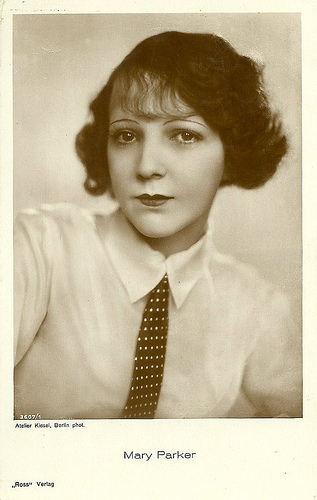
German postcard by Ross Verlag, no. 3607/1, 1928-1929. Photo: Atelier Kiesel, Berlin.
Girl From the Slums
Mary Parker was born Magdalena Prohaska in Breslau (today Wroclaw, Poland), in 1902. She debuted in the German cinema in 1924 in Die schönste Frau der Welt (Richard Eichberg, 1924) starring Lee Parry .
Quickly followed several other films, such as the comedy Lumpen und Seide (Richard Oswald, 1924), in which the rich Irene (Mary Parker) tries to refresh her marriage with Erik ( Johannes Riemann ) by taking a girl from the slums, Hilda, ( Mary Kid ) into their home. Hilda has a fiancee, Max, who is a shameless profiteer ( Reinhold Schunzel ).
Other memorable titles are Die Schmetterlingsschlacht (Franz Eckstein, 1924) starring Asta Nielsen , the Swiss production Das Paradies Europas. Bild vom Schweizer Volk und seinen Bergen (Walther Zürn, 1924-1925), and Zaungäste des Lebens (Nikolai Malikoff, 1925) with Angelo Ferari .
In Halbseide (Richard Oswald, 1925), Parker had the female lead opposite Bernd Aldor as her husband. She also had a major part in the comedy Vorderhaus und Hinterhaus (Richard Oswald, Carl Wilhelm, 1925) about a widower (Max Adalbert) who sublets a part of his house to the girl of his dreams (Parker) and her family, and in the sex education film Dürfen wir schweigen (Richard Oswald, 1926) about a painter ( Conrad Veidt) who refuses to be treated for his venereal disease.
In the following years Parker also played in films like Ich hab mein Herz in Heidelberg verloren (Arthur Bergen, 1926), Das süsse Mädel (Manfred Noa, 1926), the Danish film Dydsdragonen (Valdemar Andersen, 1927), and Todessturz im Zirkus Cesarelli ( Karoly Lajthay, 1927).
In 1928 Parker had the female leads in two films: Heut' war ich bei der Frieda (Siegfried Philippi, 1928), which title refers to the hit song of 1927, and the romantic comedy Wer das Scheiden hat erfunden (Wolfgang Neff, 1928) in which Parker played the Russian aristocrat Ljuba Pawlowa.
The song Heut' war ich bei der Frieda (text: Fritz Rotter, music: Jim Crowley): "Heut war ich bei der Frieda, das tu’ ich morgen wieder.
Denn so was wie die Frieda war noch nie da." Source: Ilja Livschakoff (YouTube).
Alive?
Mary Parker had a supporting role in Saxophon-Susi (Carl Lamac, 1928) starring Anny Ondra . In 1929 Parker had the lead of the military comedy Fräulein Fähnrich (Fred Sauer, 1929), playing opposite Willi Forst and Fritz Schulz .
Her last silent role was in Ja, ja, die Frauen sind meine schwache Seite (Edmund Heuberger, 1929). The year after she played in her first sound film, the Truus van Aalten comedy Susanne macht Ordnung (Eugen Thiele, 1930).
All in all she did some 17 silent films, of which several together with Hans Albers (Halbseide, Vorderhaus und Hinterhaus, Wer das Scheiden hat erfunden, Saxophon-Susi, Heut' war ich bei der Frieda, and Ja, ja, die Frauen sind meine schwache Seite) and Mary Kid (Lumpen und Seide, Halbseide, Vorderhaus und Hinterhaus, Dydsdragonen).
Parker had just a few performances in German sound films. After Susanne macht Ordnung she had a smaller part in Die unheimliche Geschichte (1932) by her regular director Richard Oswald and a real bit part in the Anny Ondra vehicle Die Unwiderstehliche (Geza von Bolvary, 1937), before she quitted altogether.
It is not known when or where Mary Parker died.
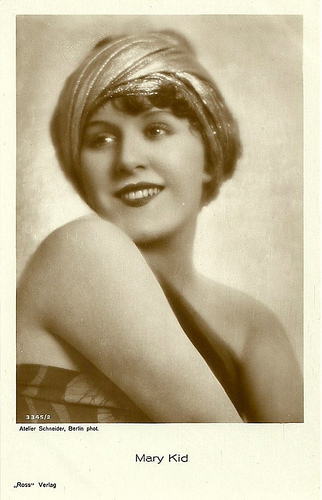
Mary Kid . German postcard by Ross Verlag, no. 3345/2, 1928-1929. Photo: Atelier Schneider, Berlin.
Sources: Thomas Staedeli (Cyranos), Filmportal.de, and .

German postcard by Ross Verlag, no. 3607/1, 1928-1929. Photo: Atelier Kiesel, Berlin.
Girl From the Slums
Mary Parker was born Magdalena Prohaska in Breslau (today Wroclaw, Poland), in 1902. She debuted in the German cinema in 1924 in Die schönste Frau der Welt (Richard Eichberg, 1924) starring Lee Parry .
Quickly followed several other films, such as the comedy Lumpen und Seide (Richard Oswald, 1924), in which the rich Irene (Mary Parker) tries to refresh her marriage with Erik ( Johannes Riemann ) by taking a girl from the slums, Hilda, ( Mary Kid ) into their home. Hilda has a fiancee, Max, who is a shameless profiteer ( Reinhold Schunzel ).
Other memorable titles are Die Schmetterlingsschlacht (Franz Eckstein, 1924) starring Asta Nielsen , the Swiss production Das Paradies Europas. Bild vom Schweizer Volk und seinen Bergen (Walther Zürn, 1924-1925), and Zaungäste des Lebens (Nikolai Malikoff, 1925) with Angelo Ferari .
In Halbseide (Richard Oswald, 1925), Parker had the female lead opposite Bernd Aldor as her husband. She also had a major part in the comedy Vorderhaus und Hinterhaus (Richard Oswald, Carl Wilhelm, 1925) about a widower (Max Adalbert) who sublets a part of his house to the girl of his dreams (Parker) and her family, and in the sex education film Dürfen wir schweigen (Richard Oswald, 1926) about a painter ( Conrad Veidt) who refuses to be treated for his venereal disease.
In the following years Parker also played in films like Ich hab mein Herz in Heidelberg verloren (Arthur Bergen, 1926), Das süsse Mädel (Manfred Noa, 1926), the Danish film Dydsdragonen (Valdemar Andersen, 1927), and Todessturz im Zirkus Cesarelli ( Karoly Lajthay, 1927).
In 1928 Parker had the female leads in two films: Heut' war ich bei der Frieda (Siegfried Philippi, 1928), which title refers to the hit song of 1927, and the romantic comedy Wer das Scheiden hat erfunden (Wolfgang Neff, 1928) in which Parker played the Russian aristocrat Ljuba Pawlowa.
The song Heut' war ich bei der Frieda (text: Fritz Rotter, music: Jim Crowley): "Heut war ich bei der Frieda, das tu’ ich morgen wieder.
Denn so was wie die Frieda war noch nie da." Source: Ilja Livschakoff (YouTube).
Alive?
Mary Parker had a supporting role in Saxophon-Susi (Carl Lamac, 1928) starring Anny Ondra . In 1929 Parker had the lead of the military comedy Fräulein Fähnrich (Fred Sauer, 1929), playing opposite Willi Forst and Fritz Schulz .
Her last silent role was in Ja, ja, die Frauen sind meine schwache Seite (Edmund Heuberger, 1929). The year after she played in her first sound film, the Truus van Aalten comedy Susanne macht Ordnung (Eugen Thiele, 1930).
All in all she did some 17 silent films, of which several together with Hans Albers (Halbseide, Vorderhaus und Hinterhaus, Wer das Scheiden hat erfunden, Saxophon-Susi, Heut' war ich bei der Frieda, and Ja, ja, die Frauen sind meine schwache Seite) and Mary Kid (Lumpen und Seide, Halbseide, Vorderhaus und Hinterhaus, Dydsdragonen).
Parker had just a few performances in German sound films. After Susanne macht Ordnung she had a smaller part in Die unheimliche Geschichte (1932) by her regular director Richard Oswald and a real bit part in the Anny Ondra vehicle Die Unwiderstehliche (Geza von Bolvary, 1937), before she quitted altogether.
It is not known when or where Mary Parker died.

Mary Kid . German postcard by Ross Verlag, no. 3345/2, 1928-1929. Photo: Atelier Schneider, Berlin.
Sources: Thomas Staedeli (Cyranos), Filmportal.de, and .
Published on February 17, 2016 22:00
February 16, 2016
Imported from the USA: Steve Cochran
Husky, darkly handsome Steve Cochran (1917- 1965) was an American film, television and stage actor, who often played boxers and gangsters during the 1940s and 1950s. One of his best known roles is the troubled drifter in Michelangelo Antonioni's Il Grido (1957), produced in Italy.
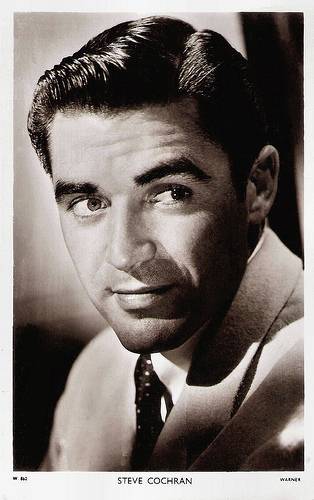
British postcard in the Picturegoer Series, London, no. W 882. Photo: Warner.
They didn't come much rougher and tougher
Steve Cochran was born Robert Alexander Cochran in Eureka, California, in 1917. He grew up in Laramie, Wyoming, the son of a logger. While he appeared in high school plays, he spent more time delving into athletics, particularly shooting hoops. After stints as a cowpuncher and railroad station hand, he studied at the University of Wyoming, where he also played basketball.
Impulsively, he quit college in 1937 and decided to go straight to Hollywood to become a star. Working as a carpenter and department store detective during his early days, he gained experience appearing in summer stock. In the early 1940s he was given the chance to work with the Shakespeare Festival in Carmel. There he played Orsino in Twelfth Night, Malcolm in Macbeth, Horatio in Hamlet and the title role of Richard III. He made his Broadway debut in Broken Hearts on Broadway (1944) and then went on to appear almost immediately in Hickory Stick.
In 1945, he landed a contract with Samuel Goldwyn. His debut was Wonder Man (H. Bruce Humberstone, 1945) with Virginia Mayo and Danny Kaye. The following years, he appeared in several films, including the Film Noir The Chase (Arthur Ripley, 1946), the war classic The Best Years of Our Lives (William Wyler, 1946) as Virginia Mayo's extra-marital fling, and A Song Is Born (Howard Hawks, 1948).
Following a notable stint as Mae West's leading stud in her 1949 revival of Diamond Lil on Broadway, Cochran was picked up by Warner Bros. From 1949 till 1952 Cochran often played boxers and gangsters for Warner. One of his most memorable roles was as psychotic mobster James Cagney’s power-hungry henchman, Big Ed Somers, in the gangster classic White Heat (Raoul Walsh, 1949). He also appeared in Highway 301 (Andrew L. Stone, 1950), as Joan Crawford's gangster paramour in The Damned Don't Cry! (Vincent Sherman, 1950), and Inside the Walls of Folsom Prison (Crane Wilbur, 1951), which inspired Johnny Cash to write his song Folsom Prison Blues.
Gary Brumburgh at IMDb : “Cochran was all man -- and a slick ladies' guy to boot. They didn't come much rougher and tougher than he both off- and on-camera. Throughout post-WWII Hollywood and the 1950s, he played the swarthiest and sexiest of coldhearted villains, with mustache or without, in a few films now considered classics. What Cochran perhaps lacked in the Gable charisma department, he certainly made up for with his own raw magnetism and sexy virility.“
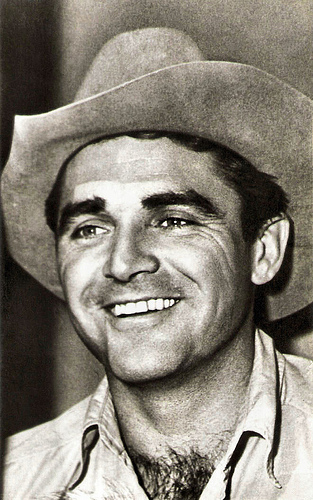
Spanish postcard, no. 725. Photo: publicity still for Highway 301 (Andrew L. Stone, 1950).
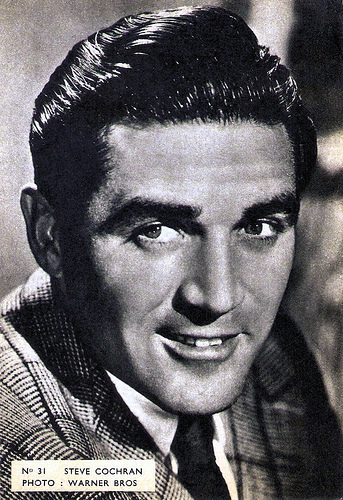
Belgian collectors card by Merbotex / Ciné British Palace, Temse, Serie B, no. 31. Photo: Warner Bros.
A prime candidate for numerous arrests
In 1953 Steve Cochran formed his own production company, Robert Alexander Productions. He won critical acclaim for two of his performances in his company's films. Cochran played a disgraced, alcoholic itinerant farmer struggling to regain the love of his family in Come Next Spring (R.G. Springsteen, 1956), and a troubled drifter in Michelangelo Antonioni's Il Grido/The Outcry (1957), produced in Italy and co-starring Alida Valli .
Cochran starred in a string of B movies throughout the 1950s, including Carnival Story (Kurt Neumann, 1954), Private Hell 36 (Don Siegel, 1954) and the British thriller The Weapon (Val Guest, 1956). He also appeared in episodes of popular television series of the era, such as The Twilight Zone (1959) and The Untouchables (1960-1961).
In the early 1960s, Cochran appeared in the Western The Deadly Companions (Sam Peckinpah, 1961) with Maureen O’Hara , and the drama Of Love and Desire (Richard Rush, 1963) starring Merle Oberon , but his career had begun a final downslide. His production company attempted to make some television series and films, but they were never produced with the exception of a television pilot where he played John C. Fremont in Fremont the Trailblazer.
A prime candidate for numerous arrests for his impulsive carousing and brawling, his living hard in the fast lane began to take its toll. His last years were marred by an obligatory Errol Flynn-type ending of drinking and debauchery. He began looking bloated and weighty. Cochran's final films were the British crime drama Mozambique (Robert Lynn, 1964) with Hildegard Knef , and the romantic drama Tell Me in the Sunlight (1965), which he had directed himself and was not released in the U.S. until 1967.
Steve Cochran was a notorious womanizer and attracted tabloid attention for his tumultuous private life, which included well-documented affairs with numerous starlets and actresses. Mamie Van Doren later wrote about their sex life in her autobiography Playing the Field: My Story (1987). He was married and divorced three times, and to artist Florence Lockwood, actress Fay McKenzie, and 19-year-old Danish emigre Hedda Jenna Jensen. He had one daughter, Xandra, by Lockwood. Cochran was the grandfather of film and television producer Alex Johns.
In 1965, Cochran died on his yacht off the coast of Guatemala, reportedly due to an acute lung infection. His body, along with three female assistants, remained aboard for ten days since the three women did not know how to operate the boat. It drifted to shore in Port Champerico, Guatemala, and was found by authorities. According to Wikipedia , there were various rumours of foul play and poisoning, but reportedly no new evidence was found. Steve Cochran was 48.
Trailer White Heat (1949). Source: MoviesHistory (YouTube).
Trailer Il Grido/The Outcry (1957). Source: Danios12345 (YouTube).
Sources: (IMDb), Wikipedia, and .

British postcard in the Picturegoer Series, London, no. W 882. Photo: Warner.
They didn't come much rougher and tougher
Steve Cochran was born Robert Alexander Cochran in Eureka, California, in 1917. He grew up in Laramie, Wyoming, the son of a logger. While he appeared in high school plays, he spent more time delving into athletics, particularly shooting hoops. After stints as a cowpuncher and railroad station hand, he studied at the University of Wyoming, where he also played basketball.
Impulsively, he quit college in 1937 and decided to go straight to Hollywood to become a star. Working as a carpenter and department store detective during his early days, he gained experience appearing in summer stock. In the early 1940s he was given the chance to work with the Shakespeare Festival in Carmel. There he played Orsino in Twelfth Night, Malcolm in Macbeth, Horatio in Hamlet and the title role of Richard III. He made his Broadway debut in Broken Hearts on Broadway (1944) and then went on to appear almost immediately in Hickory Stick.
In 1945, he landed a contract with Samuel Goldwyn. His debut was Wonder Man (H. Bruce Humberstone, 1945) with Virginia Mayo and Danny Kaye. The following years, he appeared in several films, including the Film Noir The Chase (Arthur Ripley, 1946), the war classic The Best Years of Our Lives (William Wyler, 1946) as Virginia Mayo's extra-marital fling, and A Song Is Born (Howard Hawks, 1948).
Following a notable stint as Mae West's leading stud in her 1949 revival of Diamond Lil on Broadway, Cochran was picked up by Warner Bros. From 1949 till 1952 Cochran often played boxers and gangsters for Warner. One of his most memorable roles was as psychotic mobster James Cagney’s power-hungry henchman, Big Ed Somers, in the gangster classic White Heat (Raoul Walsh, 1949). He also appeared in Highway 301 (Andrew L. Stone, 1950), as Joan Crawford's gangster paramour in The Damned Don't Cry! (Vincent Sherman, 1950), and Inside the Walls of Folsom Prison (Crane Wilbur, 1951), which inspired Johnny Cash to write his song Folsom Prison Blues.
Gary Brumburgh at IMDb : “Cochran was all man -- and a slick ladies' guy to boot. They didn't come much rougher and tougher than he both off- and on-camera. Throughout post-WWII Hollywood and the 1950s, he played the swarthiest and sexiest of coldhearted villains, with mustache or without, in a few films now considered classics. What Cochran perhaps lacked in the Gable charisma department, he certainly made up for with his own raw magnetism and sexy virility.“

Spanish postcard, no. 725. Photo: publicity still for Highway 301 (Andrew L. Stone, 1950).

Belgian collectors card by Merbotex / Ciné British Palace, Temse, Serie B, no. 31. Photo: Warner Bros.
A prime candidate for numerous arrests
In 1953 Steve Cochran formed his own production company, Robert Alexander Productions. He won critical acclaim for two of his performances in his company's films. Cochran played a disgraced, alcoholic itinerant farmer struggling to regain the love of his family in Come Next Spring (R.G. Springsteen, 1956), and a troubled drifter in Michelangelo Antonioni's Il Grido/The Outcry (1957), produced in Italy and co-starring Alida Valli .
Cochran starred in a string of B movies throughout the 1950s, including Carnival Story (Kurt Neumann, 1954), Private Hell 36 (Don Siegel, 1954) and the British thriller The Weapon (Val Guest, 1956). He also appeared in episodes of popular television series of the era, such as The Twilight Zone (1959) and The Untouchables (1960-1961).
In the early 1960s, Cochran appeared in the Western The Deadly Companions (Sam Peckinpah, 1961) with Maureen O’Hara , and the drama Of Love and Desire (Richard Rush, 1963) starring Merle Oberon , but his career had begun a final downslide. His production company attempted to make some television series and films, but they were never produced with the exception of a television pilot where he played John C. Fremont in Fremont the Trailblazer.
A prime candidate for numerous arrests for his impulsive carousing and brawling, his living hard in the fast lane began to take its toll. His last years were marred by an obligatory Errol Flynn-type ending of drinking and debauchery. He began looking bloated and weighty. Cochran's final films were the British crime drama Mozambique (Robert Lynn, 1964) with Hildegard Knef , and the romantic drama Tell Me in the Sunlight (1965), which he had directed himself and was not released in the U.S. until 1967.
Steve Cochran was a notorious womanizer and attracted tabloid attention for his tumultuous private life, which included well-documented affairs with numerous starlets and actresses. Mamie Van Doren later wrote about their sex life in her autobiography Playing the Field: My Story (1987). He was married and divorced three times, and to artist Florence Lockwood, actress Fay McKenzie, and 19-year-old Danish emigre Hedda Jenna Jensen. He had one daughter, Xandra, by Lockwood. Cochran was the grandfather of film and television producer Alex Johns.
In 1965, Cochran died on his yacht off the coast of Guatemala, reportedly due to an acute lung infection. His body, along with three female assistants, remained aboard for ten days since the three women did not know how to operate the boat. It drifted to shore in Port Champerico, Guatemala, and was found by authorities. According to Wikipedia , there were various rumours of foul play and poisoning, but reportedly no new evidence was found. Steve Cochran was 48.
Trailer White Heat (1949). Source: MoviesHistory (YouTube).
Trailer Il Grido/The Outcry (1957). Source: Danios12345 (YouTube).
Sources: (IMDb), Wikipedia, and .
Published on February 16, 2016 22:00
February 15, 2016
Myriam Bru
French actress Myriam Bru (1932) appeared in 16 European film productions of the 1950s. After her marriage to Horst Buchholz, she retired.
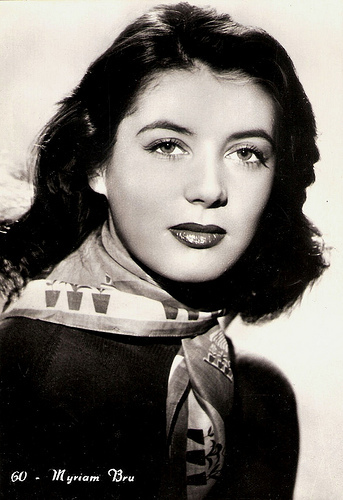
Italian postcard by Turismofoto, no. 60.
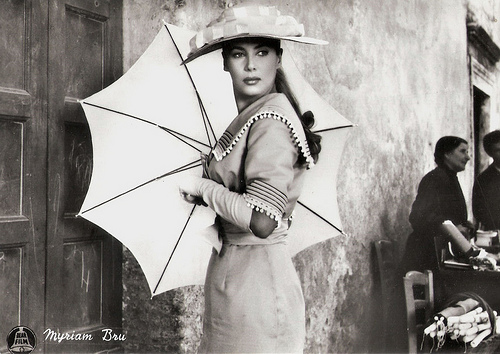
Italian postcard by Bromofoto, Milano, no. 1826. Photo: Dear Film. Publicity still for Il padrone sono me/The master is me (Franco Brusati, 1955).
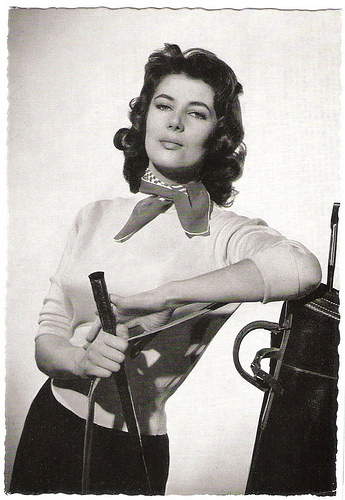
German postcard by WS-Druck, Wanne-Eickel, no. 345. Photo: Bavaria. Publicity still for Auferstehung/Résurrection (Rolf Hansen, 1958).
Puccini
Myriam (sometimes Miriam) Bru was born Myriam Rosita Bruh in 1932, in Paris, France. Her Jewish father was killed by the Nazis in camp Auschwitz-Birkenau.
She studied acting at the Cours Simon and played uncredited bit parts in French films, such as in Rendez-vous de juillet/Rendezvous in July (Jacques Becker, 1949) starring Daniel Gélin . She had her first credited role in the crime film Ouvert contre X/The Case Against X (Richard Pottier, 1952).
When she was 19, Myriam made her first Italian production. The sources differ about which production was her first. Was it Puccini (Carmine Gallone, Glauco Pellegrini, 1951), about the life of composer Giacomo Puccini played by Gabriele Ferzetti . Or was it Gian Paolo Callegari's debut film as film director, Eran trecento/They Were 300 (Gian Paolo Callegari, 1952) starring Rossano Brazzi ?
The following years she appeared in more Italian and French films like Ti ho sempre amato!/I Always Loved You! (Mario Costa, 1953) with Amedeo Nazzari , the comedy Une fille dans le soleil/A Girl in the Sun (Maurice Cam, 1953), and the melodrama Appassionatamente/Passionately (Giacomo Gentilomo, 1954).
In 1955 she appeared in Casa Ricordi/House of Ricordi (Carmine Gallone, 1955). Told in pageantlike fashion, Casa Ricordi is the story of the Ricordi family, the most prestigious music publishers in Italy. The Ricordis came up with the ‘royalty’ concept, paying artists, including Verdi (Fosco Giachetti), Donizetti (Marcello Mastroianni), Puccini ( Gabriele Ferzetti ), Bellini (Maurice Ronet) and Rossini (Roland Alexandre), for their work in perpetuity.
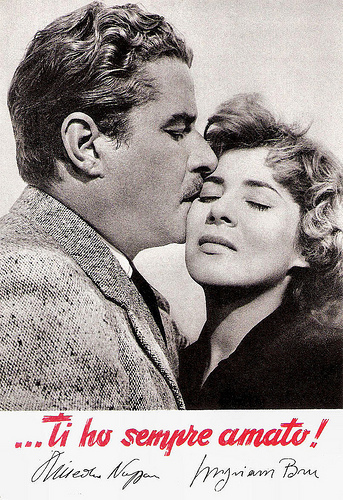
Italian promotion card by D.E.A.R. Film. Photo: Rizzoli / Royal Film / D.E.A.R. Film. Publicity still for ...ti ho sempre amato!/I Always Loved You (Mario Costa, 1953) with Amedeo Nazzari.
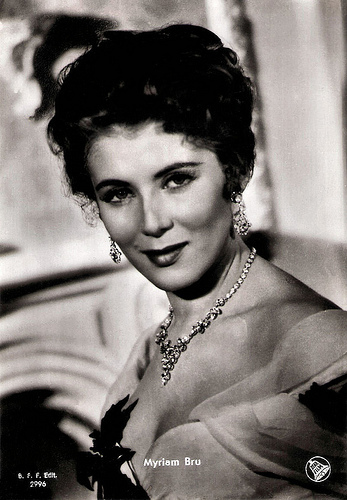
Italian postcard by B.F.F. Edit (Casa Editr. Ballerini & Fratini, Firenze), no. 2996. Photo: Dear Film. Publicity still for Appassionatamente/Passionately (Giacomo Gentilomo, 1954).
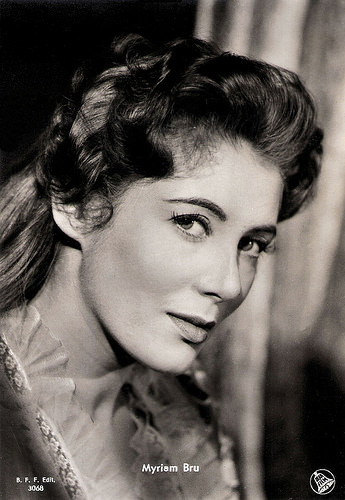
Italian postcard by B.F.F. Edit (Casa Editr. Ballerini & Fratini, Firenze), no. 3068. Photo: Dear Film. Publicity still for Appassionatamente/Passionately (Giacomo Gentilomo, 1954).
Horst
Myriam Bru next appeared opposite director Vittorio de Sica in Vacanze a Ischia/Holiday at Ischia (Mario Camerini, 1957).
In 1957 she played a leading role opposite German film idol Horst Buchholz in her first German film, Auferstehung/Resurrection (Rolf Hansen, 1958), based on a story by Leo Tolstoi. The two stars fell in love and married the next year in London, where Horst was filming Tiger Bay (J. Lee Thompson, 1959).
Buchholz pressed her to retire and to focus herself on her family. Her last film role was as a prisoner in Nella Città l'Inferno/Hell in the City (Renato Castellani, 1959), a clever melodrama starring Anna Magnani as a hard bitten prostitute whose immorality rubs off on a naive woman ( Giulietta Masina ) in a women's prison. The story was based on Isa Mari's 1953 novel Roma, Via delle Mantellate.
Myriam Bru and Horst Buchholz stayed married till his death in 2003, although they lived separately during the last years. They had a son, actor/director Christopher Buchholz, and a daughter, Beatrice Buchholz.
Later in life, after her children were grown up, Myriam Bru managed an actor’s agency in Paris. Among her discoveries are Mathilda May and Mélanie Thierry. She appeared in a documentary Christopher made about his father, Horst Buchholz... mein Papa/Horst Buchholz… My Dad (Christopher Buchholz, Sandra Hacker, 2005).

French postcard by Editions du Globe, Paris, no. 307. Photo: Sam Lévin.
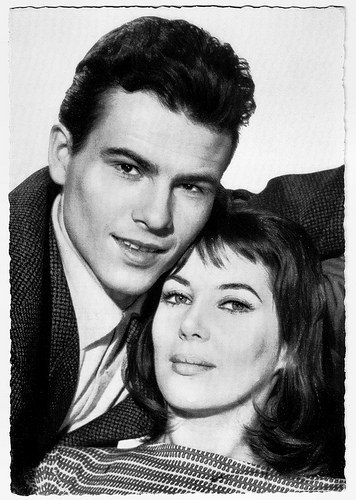
German postcard by WS-Druck, Wanne-Eickel, no. 368.
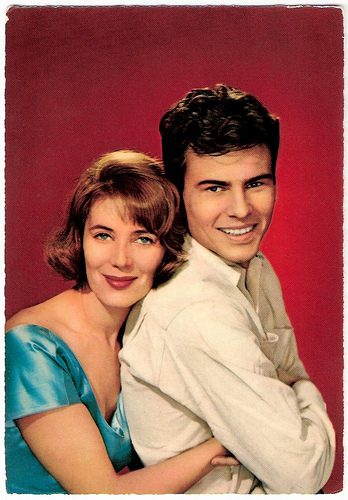
With Horst Buchholz . German postcard by Krüger, no. 902/94. Photo: Sam Levin.
Sources: Wikipedia, AllMovie, and .

Italian postcard by Turismofoto, no. 60.

Italian postcard by Bromofoto, Milano, no. 1826. Photo: Dear Film. Publicity still for Il padrone sono me/The master is me (Franco Brusati, 1955).

German postcard by WS-Druck, Wanne-Eickel, no. 345. Photo: Bavaria. Publicity still for Auferstehung/Résurrection (Rolf Hansen, 1958).
Puccini
Myriam (sometimes Miriam) Bru was born Myriam Rosita Bruh in 1932, in Paris, France. Her Jewish father was killed by the Nazis in camp Auschwitz-Birkenau.
She studied acting at the Cours Simon and played uncredited bit parts in French films, such as in Rendez-vous de juillet/Rendezvous in July (Jacques Becker, 1949) starring Daniel Gélin . She had her first credited role in the crime film Ouvert contre X/The Case Against X (Richard Pottier, 1952).
When she was 19, Myriam made her first Italian production. The sources differ about which production was her first. Was it Puccini (Carmine Gallone, Glauco Pellegrini, 1951), about the life of composer Giacomo Puccini played by Gabriele Ferzetti . Or was it Gian Paolo Callegari's debut film as film director, Eran trecento/They Were 300 (Gian Paolo Callegari, 1952) starring Rossano Brazzi ?
The following years she appeared in more Italian and French films like Ti ho sempre amato!/I Always Loved You! (Mario Costa, 1953) with Amedeo Nazzari , the comedy Une fille dans le soleil/A Girl in the Sun (Maurice Cam, 1953), and the melodrama Appassionatamente/Passionately (Giacomo Gentilomo, 1954).
In 1955 she appeared in Casa Ricordi/House of Ricordi (Carmine Gallone, 1955). Told in pageantlike fashion, Casa Ricordi is the story of the Ricordi family, the most prestigious music publishers in Italy. The Ricordis came up with the ‘royalty’ concept, paying artists, including Verdi (Fosco Giachetti), Donizetti (Marcello Mastroianni), Puccini ( Gabriele Ferzetti ), Bellini (Maurice Ronet) and Rossini (Roland Alexandre), for their work in perpetuity.

Italian promotion card by D.E.A.R. Film. Photo: Rizzoli / Royal Film / D.E.A.R. Film. Publicity still for ...ti ho sempre amato!/I Always Loved You (Mario Costa, 1953) with Amedeo Nazzari.

Italian postcard by B.F.F. Edit (Casa Editr. Ballerini & Fratini, Firenze), no. 2996. Photo: Dear Film. Publicity still for Appassionatamente/Passionately (Giacomo Gentilomo, 1954).

Italian postcard by B.F.F. Edit (Casa Editr. Ballerini & Fratini, Firenze), no. 3068. Photo: Dear Film. Publicity still for Appassionatamente/Passionately (Giacomo Gentilomo, 1954).
Horst
Myriam Bru next appeared opposite director Vittorio de Sica in Vacanze a Ischia/Holiday at Ischia (Mario Camerini, 1957).
In 1957 she played a leading role opposite German film idol Horst Buchholz in her first German film, Auferstehung/Resurrection (Rolf Hansen, 1958), based on a story by Leo Tolstoi. The two stars fell in love and married the next year in London, where Horst was filming Tiger Bay (J. Lee Thompson, 1959).
Buchholz pressed her to retire and to focus herself on her family. Her last film role was as a prisoner in Nella Città l'Inferno/Hell in the City (Renato Castellani, 1959), a clever melodrama starring Anna Magnani as a hard bitten prostitute whose immorality rubs off on a naive woman ( Giulietta Masina ) in a women's prison. The story was based on Isa Mari's 1953 novel Roma, Via delle Mantellate.
Myriam Bru and Horst Buchholz stayed married till his death in 2003, although they lived separately during the last years. They had a son, actor/director Christopher Buchholz, and a daughter, Beatrice Buchholz.
Later in life, after her children were grown up, Myriam Bru managed an actor’s agency in Paris. Among her discoveries are Mathilda May and Mélanie Thierry. She appeared in a documentary Christopher made about his father, Horst Buchholz... mein Papa/Horst Buchholz… My Dad (Christopher Buchholz, Sandra Hacker, 2005).

French postcard by Editions du Globe, Paris, no. 307. Photo: Sam Lévin.

German postcard by WS-Druck, Wanne-Eickel, no. 368.

With Horst Buchholz . German postcard by Krüger, no. 902/94. Photo: Sam Levin.
Sources: Wikipedia, AllMovie, and .
Published on February 15, 2016 22:00
February 14, 2016
Martha Novelly
Martha Novelly (1889-1972) was a German stage and screen actress who peaked in the German silent film of the late 1910s.
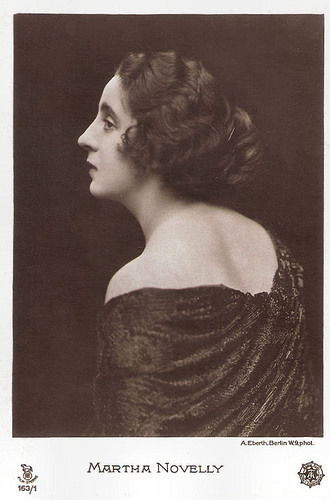
German postcard in the Film-Sterne series by Rotophot, no. 163/1. Photo: A. Eberth, Berlin / Astra Film.
Several spectacular scenes
Martha Novelly was born Martha Buchholz in Hamburg, Germany, in 1889.
At age 15, she debuted on the stage in 1904 in Lübeck. Afterwards she acted in Flensburg, Oldenburg, Frankfurt (Oder), Chemnitz, Nürnberg and Stuttgart. From 1914 she performed in Berlin at the Lustspielhaus.
Just like many of her fellow stage actors in Berlin, she started a film acting career during the First World War. Her first part was that of Edith, one of the general’s daughters in General von Berning (Heinrich Bolten-Baeckers, 1914), starring Albert Paul, Aranka Keller, Leo Peukert and Ernst Hofmann . About the same time Novelly also played with again Paul, Keller and Hofmann in Bolten-Baeckers’ Um Liebe und Ehre/To love and honour (Heinrich Bolten-Baeckers, 1914).
Novelly was absent from the film set in 1915. Then she had the female lead in the Harry Piel adventure film Unter heisser Zone/Under Hot Zone (1916), with Mogens Enger, Preben Rist and Viktor Janson. The story dealt with a captain (Enger) hunting for a precious South-African diamond, stolen by a Dutch swindler (Rist) and his American accomplice (Novelly). Shots were taken in Berlin, the Hamburg Zoo and aboard the ship Kaiserin Auguste Viktoria.
Until the end of the First World War, Unter heisser Zone was Harry Piel ’s most ambitious production. It announced his post-war specialisation of adventure films with wild animals. The film contained several spectacular scenes, including a lion hunt, a car falling into an abyss, the explosion of a kettle, a chase on a ship, and an explosion of a bridge just before a luxury train arrives, causing only the locomotive to drop down.
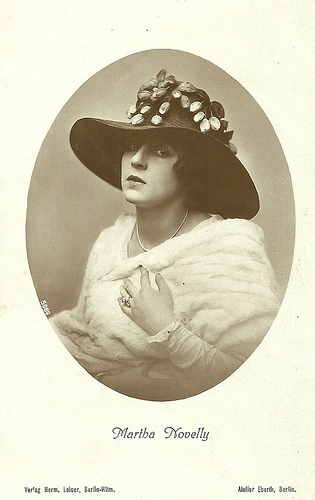
German postcard by Verlag Hermann Leiser, Berlin. Photo: Atelier Eberth, Berlin.
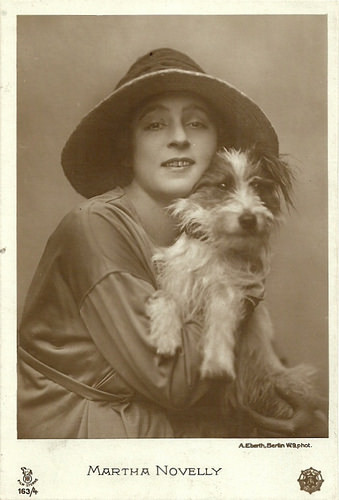
German postcard in the Film-Sterne series by Rotophot, no. 163/4. Photo: Atelier Eberth, Berlin / Astra Film.
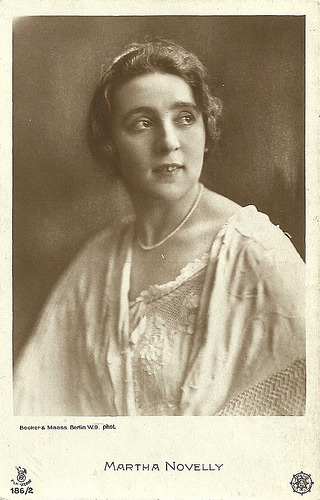
German postcard in the Film-Sterne series by Rotophot, no. 186/2. Photo: Becker & Maass, Berlin / Astra Film.
Serious dramatic films
Between 1916 and 1918 Martha Novelly was a leading film actress in serious, dramatic films. From 1917 she acted as star in several dramas of the Astra Film company, directed by Emerich Hanus, including Unheilbar/Incurable (1917) with small parts for Emil Jannings and Werner Krauss , Das Gewissen des Andern/The conscience of others (1917) with Bruno Decarli , Bruno Kastner and Theodor Loos , and E – der scharlachrote Buchstabe/E - the scarlet letter (1918) with Werner Krauss .
In Die Sühne/Atonement (Emmerich Hanus, 1917), Renate (Novelly) and Ludwig ( Kurt Vespermann ), who have been friends already in childhood, fall in love with each other. When Ludwig is blinded by accident, Renate takes care of him. She becomes a sculptress and opens a studio in his house. Ludwig starts to flirt with a model, the dancer Sibylle (Lore Rückert). When a doctor restores his sight, he is appalled by Renate’s loss of beauty and chases the dancer, until he finds out she is only after his money. Clearly Ludwig, needs to be cured of his spiritual blindness as well. A print of the film was found back at the EYE Film Institute Netherlands and restored in Germany.
In Die Liebe der Maria Bonde/The Love of Maria Bonde (Emmerich Hanus, 1918), Novelly is Maria Bonde, the middle sister of family of three daughters. The eldest daughter Gunne (Eva Maria Hartmann) is betrothed to Martin, a circus rider (Emerich Hanus) with whom she acts together. He instead prefers Maria, declares her his love when she substitutes for Gunne in the circus. He elopes with her, causing the death of Gunne. When Maria has a child and cannot perform, it is now her youngest sister Anella (Ursula Hell) to substitute her in the circus. Will Martin dump Maria now? Maria has visions of her deceased sister warning her, and of her mother catching her and Martin kissing.
A few years after her marriage in 1918, Martha Novelly ended her short film career. Her films of 1919 were for the company Deutsche Bioscop: Flitter-Dörtje/Bauble Dortje (Robert Leffler, 1919) with Charles Willy Kaiser and Rudolf Klein-Rogge , and Die Geige des Tommaso/The violin of Tommaso (Emerich Hanus, 1919).
Novelly’s last films were Cagliostros Totenhand/Cagliostro's dead hand (Nils Olaf Chrisander, 1919) with Eugen Klöpfer, and the French production Irène (Marcel Dumont, 1920) starring Louise Colliney as Irène and Marcel Vibert .
Martha Novelly died in 1972 in Berlin.
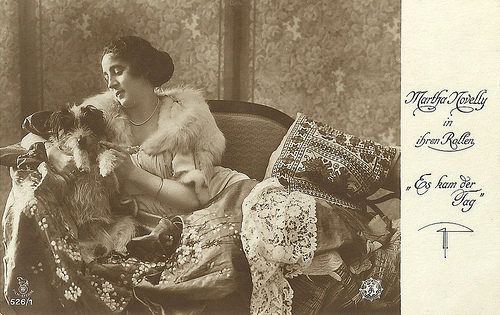
German postcard in the Film Sterne series by Rotophot, no. 526/1. Photo: Astra-Film. Publicity still for Es kam der Tag (1918).
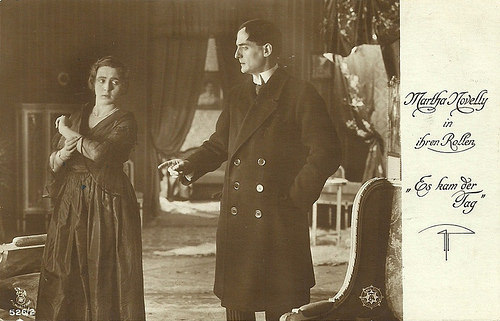
German postcard in the Film Sterne series by Rotophot, no. 526/2. Photo: Astra-Film. Publicity still for Es kam der Tag (1918).
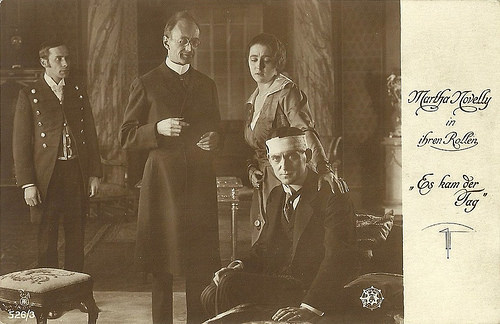
German postcard in the Film Sterne series by Rotophot, no. 526/3. Photo: Astra-Film. Publicity still for Es kam der Tag (1918).
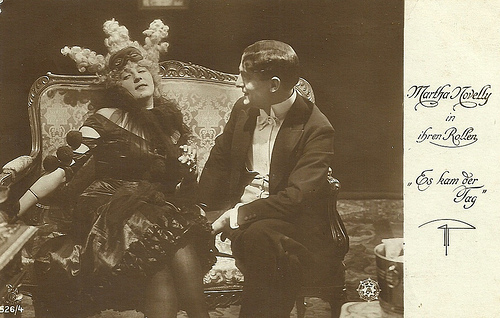
German postcard in the Film Sterne series by Rotophot, no. 526/4. Photo: Astra-Film. Publicity still for Es kam der Tag (1918).
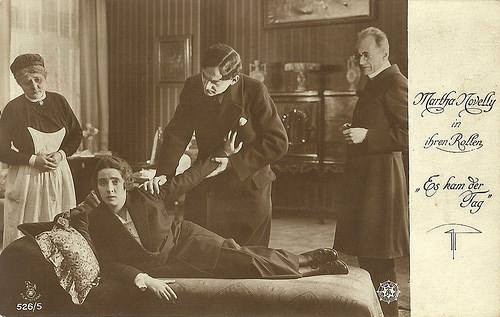
German postcard in the Film Sterne series by Rotophot, no. 526/5. Photo: Astra-Film. Publicity still for Es kam der Tag (1918).
Sources: Rot für Gefahr, Feuer und Liebe (German), Filmportal. de, The German Early Cinema Database, Wikipedia (German), and . For Die Liebe der Maria Bonde, see European film gateway.

German postcard in the Film-Sterne series by Rotophot, no. 163/1. Photo: A. Eberth, Berlin / Astra Film.
Several spectacular scenes
Martha Novelly was born Martha Buchholz in Hamburg, Germany, in 1889.
At age 15, she debuted on the stage in 1904 in Lübeck. Afterwards she acted in Flensburg, Oldenburg, Frankfurt (Oder), Chemnitz, Nürnberg and Stuttgart. From 1914 she performed in Berlin at the Lustspielhaus.
Just like many of her fellow stage actors in Berlin, she started a film acting career during the First World War. Her first part was that of Edith, one of the general’s daughters in General von Berning (Heinrich Bolten-Baeckers, 1914), starring Albert Paul, Aranka Keller, Leo Peukert and Ernst Hofmann . About the same time Novelly also played with again Paul, Keller and Hofmann in Bolten-Baeckers’ Um Liebe und Ehre/To love and honour (Heinrich Bolten-Baeckers, 1914).
Novelly was absent from the film set in 1915. Then she had the female lead in the Harry Piel adventure film Unter heisser Zone/Under Hot Zone (1916), with Mogens Enger, Preben Rist and Viktor Janson. The story dealt with a captain (Enger) hunting for a precious South-African diamond, stolen by a Dutch swindler (Rist) and his American accomplice (Novelly). Shots were taken in Berlin, the Hamburg Zoo and aboard the ship Kaiserin Auguste Viktoria.
Until the end of the First World War, Unter heisser Zone was Harry Piel ’s most ambitious production. It announced his post-war specialisation of adventure films with wild animals. The film contained several spectacular scenes, including a lion hunt, a car falling into an abyss, the explosion of a kettle, a chase on a ship, and an explosion of a bridge just before a luxury train arrives, causing only the locomotive to drop down.

German postcard by Verlag Hermann Leiser, Berlin. Photo: Atelier Eberth, Berlin.

German postcard in the Film-Sterne series by Rotophot, no. 163/4. Photo: Atelier Eberth, Berlin / Astra Film.

German postcard in the Film-Sterne series by Rotophot, no. 186/2. Photo: Becker & Maass, Berlin / Astra Film.
Serious dramatic films
Between 1916 and 1918 Martha Novelly was a leading film actress in serious, dramatic films. From 1917 she acted as star in several dramas of the Astra Film company, directed by Emerich Hanus, including Unheilbar/Incurable (1917) with small parts for Emil Jannings and Werner Krauss , Das Gewissen des Andern/The conscience of others (1917) with Bruno Decarli , Bruno Kastner and Theodor Loos , and E – der scharlachrote Buchstabe/E - the scarlet letter (1918) with Werner Krauss .
In Die Sühne/Atonement (Emmerich Hanus, 1917), Renate (Novelly) and Ludwig ( Kurt Vespermann ), who have been friends already in childhood, fall in love with each other. When Ludwig is blinded by accident, Renate takes care of him. She becomes a sculptress and opens a studio in his house. Ludwig starts to flirt with a model, the dancer Sibylle (Lore Rückert). When a doctor restores his sight, he is appalled by Renate’s loss of beauty and chases the dancer, until he finds out she is only after his money. Clearly Ludwig, needs to be cured of his spiritual blindness as well. A print of the film was found back at the EYE Film Institute Netherlands and restored in Germany.
In Die Liebe der Maria Bonde/The Love of Maria Bonde (Emmerich Hanus, 1918), Novelly is Maria Bonde, the middle sister of family of three daughters. The eldest daughter Gunne (Eva Maria Hartmann) is betrothed to Martin, a circus rider (Emerich Hanus) with whom she acts together. He instead prefers Maria, declares her his love when she substitutes for Gunne in the circus. He elopes with her, causing the death of Gunne. When Maria has a child and cannot perform, it is now her youngest sister Anella (Ursula Hell) to substitute her in the circus. Will Martin dump Maria now? Maria has visions of her deceased sister warning her, and of her mother catching her and Martin kissing.
A few years after her marriage in 1918, Martha Novelly ended her short film career. Her films of 1919 were for the company Deutsche Bioscop: Flitter-Dörtje/Bauble Dortje (Robert Leffler, 1919) with Charles Willy Kaiser and Rudolf Klein-Rogge , and Die Geige des Tommaso/The violin of Tommaso (Emerich Hanus, 1919).
Novelly’s last films were Cagliostros Totenhand/Cagliostro's dead hand (Nils Olaf Chrisander, 1919) with Eugen Klöpfer, and the French production Irène (Marcel Dumont, 1920) starring Louise Colliney as Irène and Marcel Vibert .
Martha Novelly died in 1972 in Berlin.

German postcard in the Film Sterne series by Rotophot, no. 526/1. Photo: Astra-Film. Publicity still for Es kam der Tag (1918).

German postcard in the Film Sterne series by Rotophot, no. 526/2. Photo: Astra-Film. Publicity still for Es kam der Tag (1918).

German postcard in the Film Sterne series by Rotophot, no. 526/3. Photo: Astra-Film. Publicity still for Es kam der Tag (1918).

German postcard in the Film Sterne series by Rotophot, no. 526/4. Photo: Astra-Film. Publicity still for Es kam der Tag (1918).

German postcard in the Film Sterne series by Rotophot, no. 526/5. Photo: Astra-Film. Publicity still for Es kam der Tag (1918).
Sources: Rot für Gefahr, Feuer und Liebe (German), Filmportal. de, The German Early Cinema Database, Wikipedia (German), and . For Die Liebe der Maria Bonde, see European film gateway.
Published on February 14, 2016 22:00
February 13, 2016
Vitali Konyaev
Russian actor Vitali Konyayev (1937) is honored as a people’s artist of Russia. Next to his theatre work, he appeared in a dozen films and he also worked as a director and acting teacher.
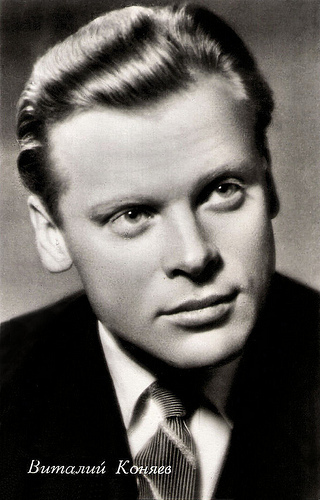
Russian postcard by Izdanije Byuro Propogandy Sovietskogo Kinoiskusstva, no. M 74663, 1962.

Russian postcard by Izdanije Byuro Propogandy Sovietskogo Kinoiskusstva, no. A 03168, 1965. Photo: B. Vilenkin, G. Ter-Ovanesov. (This postcard was printed in an edition of 200.000 cards. The price was 8 kop.)
Silence
Vitali A. Konyaev (in Russian written as Виталий Коняев and in French as Vitali Koniaev) was born in Kronstadt in the former Soviet Union, now Russia, in 1937. from 1954 till 1958, he studied acting with L. Volkova at the M. S. Schepkin Higher Theatre School and from 1958 he worked for the State Academic Maly Theater.
In 1958 he also made his film debut with a small part in Stuchis' v lyubuyu dver'/Knock On Any Door (Mariya Fyodorova, 1958). More roles soon followed in films like Nasch Korrespondent/Our Correspondent (Anatoli Granik, 1958) and the lead role in Pesnya o Koltsove/A Song about Koltsov (Vladimir Gerasimov II, 1959), about the life of Russian poet Alexey Koltsov.
Konyaev played a supporting part in Chistoe nebo/Clear Skies (Grigori Chukhrai, 1961), a drama starring Yevgeny Urbansky . It is the story of a Soviet test pilot taken prisoner by the Nazis during World War II only to find himself expelled from the Communist Party on his release. Fired from his job, and deprived of all decorations, he becomes a drunk. His only solace lies in the love of his wife, as she challenges him to right the wrongs done to him.
This film was possible only after Joseph Stalin's death when his successor Nikita Khrushchev in 1956 denounced the 'cult of personality' and all of Stalin's purges. Still, Chukhrai had a hard and very delicate task on his hands because he had to portray the issue while still following the propaganda guide-lines and affirming the righteousness of the whole communist system, so that the film would actually pass the censors. He told the story seen through the eyes of the young wife of the pilot, played by Nina Drobysheva. Konyayev would later marry Drobysheva.
Next Vitali Konyaev played one of the leading roles in Tishina/Silence (Vladimir Basov, 1963) based on the novel by Yuri Bondareva. In this film, a young World War II hero's moral and political resolve is tested when he and his father are drummed out of the Communist Party.
At AllMovie , Dan Pavlides writes: "Sergei (Vitali Konyayev) resents his father for taking a lover, but his morals do not stop his own affair with a woman separated from her husband. After the war, Sergei enters the institute hoping to further his education, but he too is kicked out of the Party and the institute for the sins of his father. Vladimir Basov, a famous character actor in his own right, directed the film that was seen by over 50 million people in the USSR alone. This is one of the last films that fell under the political thaw period under Khruschev and openly depicted Stalinist oppression."
The film won the Grand Prize at the Vsesoyuznyy kinofestival (All-Union Film Festival) in Leningrad in 1964. That same year, Leonid Brezhnev rose to power and this sort of commentary would once again be forbidden.
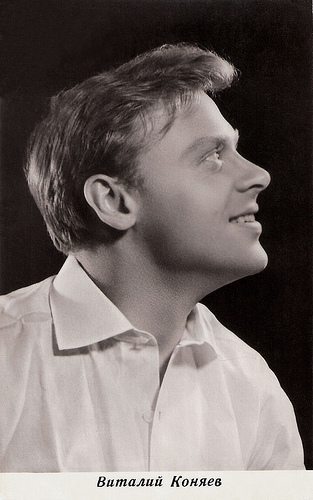
Russian postcard by Izdanije Byuro Propogandy Sovietskogo Kinoiskusstva, no. M 14943, 1965. (This postcard was printed in an edition of 115 - 150.000 cards. The price was 8 kop.)
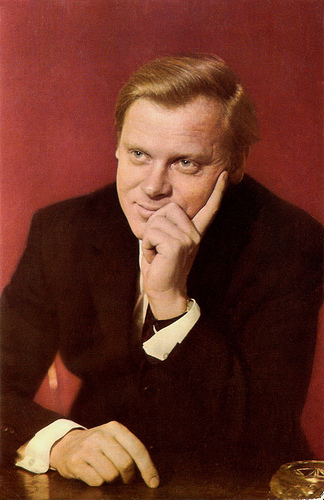
Russian postcard by Izdanije Byuro Propogandy Sovietskogo Kinoiskusstva, no. 2428, 1970. Photo: G. & T. Vajl. (This postcard was printed in an edition of 200.000 cards. The price was 6 kop.)
The Red and the White
Vitali Konyaev had a small part in the controversial Hungarian-Soviet co-production Csillagosok, katonák/The Red and the White (Miklós Jancsó, 1967). The film was originally commissioned to celebrate the 50th anniversary of the October Revolution in Russia in which the Bolsheviks took power.
However, director Miklós Jancsó chose to use a radically different approach to the film than was expected. As a result, the film was not well received in Russia, where it was first re-edited to put a more heroic spin on the war for its premiere and then banned. However, in Hungary and in the West it was favourably received and it had a theatrical release in many countries.
Next Konyaev played the lead in the political drama Belyy flyuger/A White Weather Vane (David Kocharyan, 1969), and also appeared in films like Gorod pod lipami/The City of Lipami (Alois Brench, 1971) and Samyy posledniy den/The Very Last Day (Mikhail Ulyanov, 1972).
From 1972 till 1982 he worked as a teacher at the M.S. Schepkin Higher Theatre School. During this period he played in the TV-series Variant ‘Оmegа’/Option ‘Omega’ (Antonis Vogiazos, 1975) and the adventure film Tovarishch Innokentiy/Comrade Innocent (Yevgeni Mezentsev, Iosif Shapiro, 1981).
More recent films in which he played small parts were the German-Russian coproduction Ubit drakona/To Kill a Dragon (Mark Zakharov, 1988) and the black comedy Vystrel v grobu/Shot in a Coffin (Nikolai Zaseyev, 1992). In 1998 Vitali Konyayev was given the title of People's Artist of Russia.
Vitali Konyaev is married to Tatiana Konyaeva-Stanislavski. He has a daughter, actress Yelena Drobysheva (1964), and a son, Dmitry V. Konyaev (1987).
Trailer for Csillagosok, katonák/The Red and the White (1967).
Sources: Dan Pavlides (AllMovie), Kino-teatr (Russian), Wikipedia and .

Russian postcard by Izdanije Byuro Propogandy Sovietskogo Kinoiskusstva, no. M 74663, 1962.

Russian postcard by Izdanije Byuro Propogandy Sovietskogo Kinoiskusstva, no. A 03168, 1965. Photo: B. Vilenkin, G. Ter-Ovanesov. (This postcard was printed in an edition of 200.000 cards. The price was 8 kop.)
Silence
Vitali A. Konyaev (in Russian written as Виталий Коняев and in French as Vitali Koniaev) was born in Kronstadt in the former Soviet Union, now Russia, in 1937. from 1954 till 1958, he studied acting with L. Volkova at the M. S. Schepkin Higher Theatre School and from 1958 he worked for the State Academic Maly Theater.
In 1958 he also made his film debut with a small part in Stuchis' v lyubuyu dver'/Knock On Any Door (Mariya Fyodorova, 1958). More roles soon followed in films like Nasch Korrespondent/Our Correspondent (Anatoli Granik, 1958) and the lead role in Pesnya o Koltsove/A Song about Koltsov (Vladimir Gerasimov II, 1959), about the life of Russian poet Alexey Koltsov.
Konyaev played a supporting part in Chistoe nebo/Clear Skies (Grigori Chukhrai, 1961), a drama starring Yevgeny Urbansky . It is the story of a Soviet test pilot taken prisoner by the Nazis during World War II only to find himself expelled from the Communist Party on his release. Fired from his job, and deprived of all decorations, he becomes a drunk. His only solace lies in the love of his wife, as she challenges him to right the wrongs done to him.
This film was possible only after Joseph Stalin's death when his successor Nikita Khrushchev in 1956 denounced the 'cult of personality' and all of Stalin's purges. Still, Chukhrai had a hard and very delicate task on his hands because he had to portray the issue while still following the propaganda guide-lines and affirming the righteousness of the whole communist system, so that the film would actually pass the censors. He told the story seen through the eyes of the young wife of the pilot, played by Nina Drobysheva. Konyayev would later marry Drobysheva.
Next Vitali Konyaev played one of the leading roles in Tishina/Silence (Vladimir Basov, 1963) based on the novel by Yuri Bondareva. In this film, a young World War II hero's moral and political resolve is tested when he and his father are drummed out of the Communist Party.
At AllMovie , Dan Pavlides writes: "Sergei (Vitali Konyayev) resents his father for taking a lover, but his morals do not stop his own affair with a woman separated from her husband. After the war, Sergei enters the institute hoping to further his education, but he too is kicked out of the Party and the institute for the sins of his father. Vladimir Basov, a famous character actor in his own right, directed the film that was seen by over 50 million people in the USSR alone. This is one of the last films that fell under the political thaw period under Khruschev and openly depicted Stalinist oppression."
The film won the Grand Prize at the Vsesoyuznyy kinofestival (All-Union Film Festival) in Leningrad in 1964. That same year, Leonid Brezhnev rose to power and this sort of commentary would once again be forbidden.

Russian postcard by Izdanije Byuro Propogandy Sovietskogo Kinoiskusstva, no. M 14943, 1965. (This postcard was printed in an edition of 115 - 150.000 cards. The price was 8 kop.)

Russian postcard by Izdanije Byuro Propogandy Sovietskogo Kinoiskusstva, no. 2428, 1970. Photo: G. & T. Vajl. (This postcard was printed in an edition of 200.000 cards. The price was 6 kop.)
The Red and the White
Vitali Konyaev had a small part in the controversial Hungarian-Soviet co-production Csillagosok, katonák/The Red and the White (Miklós Jancsó, 1967). The film was originally commissioned to celebrate the 50th anniversary of the October Revolution in Russia in which the Bolsheviks took power.
However, director Miklós Jancsó chose to use a radically different approach to the film than was expected. As a result, the film was not well received in Russia, where it was first re-edited to put a more heroic spin on the war for its premiere and then banned. However, in Hungary and in the West it was favourably received and it had a theatrical release in many countries.
Next Konyaev played the lead in the political drama Belyy flyuger/A White Weather Vane (David Kocharyan, 1969), and also appeared in films like Gorod pod lipami/The City of Lipami (Alois Brench, 1971) and Samyy posledniy den/The Very Last Day (Mikhail Ulyanov, 1972).
From 1972 till 1982 he worked as a teacher at the M.S. Schepkin Higher Theatre School. During this period he played in the TV-series Variant ‘Оmegа’/Option ‘Omega’ (Antonis Vogiazos, 1975) and the adventure film Tovarishch Innokentiy/Comrade Innocent (Yevgeni Mezentsev, Iosif Shapiro, 1981).
More recent films in which he played small parts were the German-Russian coproduction Ubit drakona/To Kill a Dragon (Mark Zakharov, 1988) and the black comedy Vystrel v grobu/Shot in a Coffin (Nikolai Zaseyev, 1992). In 1998 Vitali Konyayev was given the title of People's Artist of Russia.
Vitali Konyaev is married to Tatiana Konyaeva-Stanislavski. He has a daughter, actress Yelena Drobysheva (1964), and a son, Dmitry V. Konyaev (1987).
Trailer for Csillagosok, katonák/The Red and the White (1967).
Sources: Dan Pavlides (AllMovie), Kino-teatr (Russian), Wikipedia and .
Published on February 13, 2016 22:00
February 12, 2016
Brigitte Horney
Charismatic German theatre and film actress Brigitte Horney (1911-1988) worked both in German and English films. Her earthy charm, prominent cheekbones and deep, sultry voice made her stand out from her colleagues. She is best remembered as Empress Catherine the Great in the lavish UFA spectacle Baron Munchhausen (1943). After the war she moved to the US and became an American citizen.
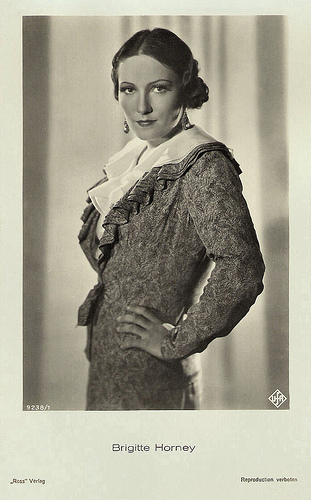
German postcard by Ross-Verlag, no. 9238/1, 1935-1936. Photo: Ufa.
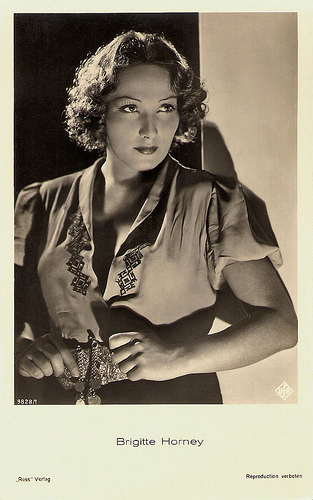
German postcard by Ross-Verlag, no. 9828/1, 1935-1936. Photo: Ufa.
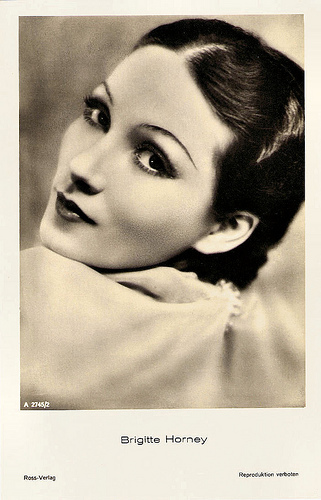
German postcard by Ross-Verlag, no. A 2745, 1941-1944.
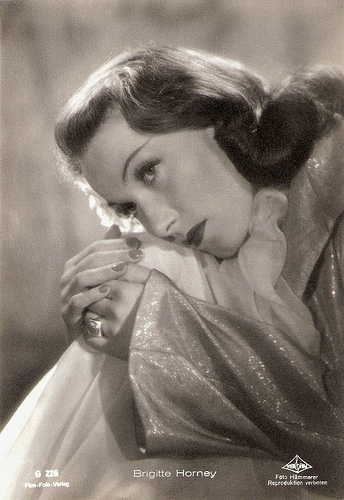
German postcard by Film-Foto-Verlag, no. G 228. Photo: Hämmerer.
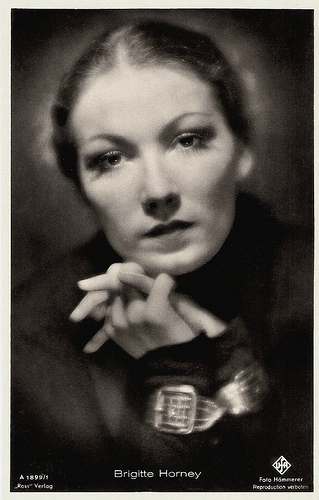
German postcard by Ross Verlag, no. A 1899/1, 1941-1944. Photo: Ufa / Hämmerer.
Forgotten Masterpiece
Brigitte Horney was born in 1911, in Berlin-Dahlem, Germany. She was the daughter of Karen Horney-Danielsen, a noted German psychoanalyst, and Oscar Horney, an industrialist from Berlin. She had a bilingual education. Brigitte attended lessons for expressive dance by the legendary Mary Wigman and also acting classes by actress Ilka Grüning at the Ilka-Grüning-Schule in Berlin.
She began her stage career in Würzburg, and was, for more than a decade, engaged by Berlin's Volksbühne. Already in 1930 she won the Max-Reinhardt-Preis as up-and-coming actress. Young director Robert Siodmak discovered her for the cinema and cast her as a sales clerk in his film Abschied/Farewell (Robert Siodmak, 1930), the first sound film of the Ufa and according to reviewer Stanislas Lefort at IMDb a ‘forgotten masterpiece’.
The young actress refused the contract that Ufa offered her, because she wanted to continue her stage career. But in the next years Horney would also appear in films like Fra Diavolo (Mario Bonnard, 1931), Rasputin, Dämon der Frauen/Rasputin (Adolf Trotz, 1932) featuring Conrad Veidt , and Ein Mann will nach Deutschland/A Man Wants to Get to Germany (Paul Wegener, 1934) with Karl Ludwig Diehl .
Although her mother had escaped to New York, Horney opportunistically remained in the Third Reich. When she accepted the starring role as a waterfront girl in in the highly popular film Liebe, Tod und Teufel/Love, Death and the Devil (Heinz Hilpert, Reinhart Steinbicker, 1934) with Käthe von Nagy . A new star was born when she sang in her inimitable husky voice So oder so ist das Leben (So or so is life), written by Theo Mackeben. It became her Leitmotiv song. Critics and audiences alike compared her favorably to Marlene Dietrich .
This success was followed by such films as Savoy-Hotel 217 (Gustav Ucicky, 1936) opposite Hans Albers , the English films The House of the Spaniard (Reginald Denham, 1936) and Secret Lives (Edmond T. Gréville, 1937) as well as Der Katzensteg/The Cat’s Alley (Fritz Peter Buch, 1937), Anna Favetti (Erich Waschneck, 1938) with Mathias Wieman, and Befreite Hände/Freed Hands (Hans Schweikart, 1939) with Olga Tschechova . In these films she often played strong women, not unlike herself.
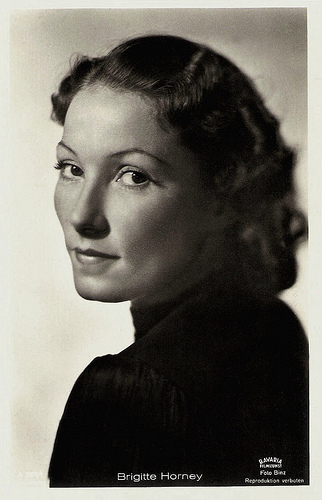
German postcard by Ross-Verlag, no. 3378/1, 1941-1944. Photo: Bavaria / Binz.
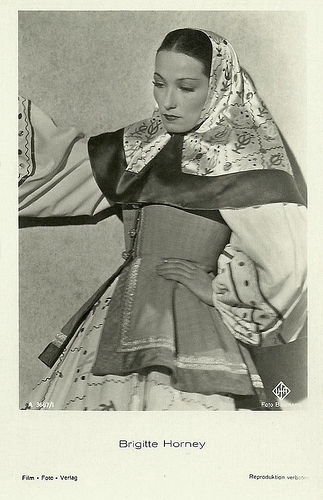
German postcard by Film-Foto-Verlag, no. 3667/1, 1941-1944. Photo: Baumann / Ufa.
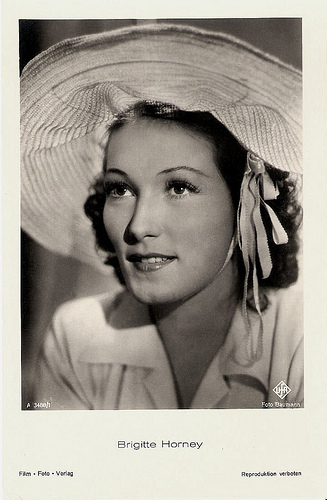
German postcard by Film-Foto-Verlag, no. A 3480/1, 1941-1944. Photo: Ufa / Baumann.
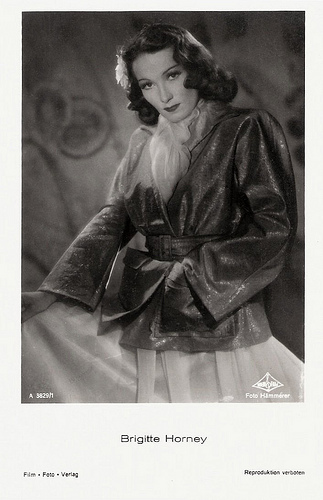
German postcard by Film-Foto-Verlag, no. A 3829/1, 1941-1944. Photo: Hämmerer / Wien Film.
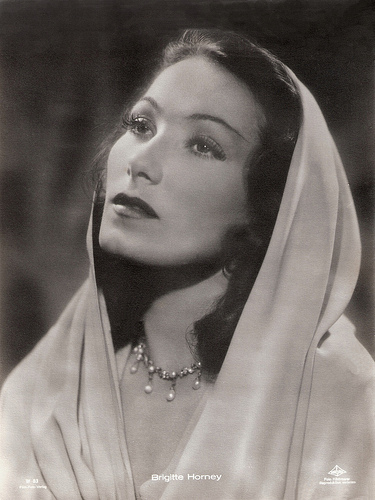
Big German card by Film-Foto-Verlag, no. W 83, 1941-1944. Photo: Wien-Film / Hämmerer.
Tuberculosis
When Brigitte Horney appeared at Joachim Gottschalk 's side in Du und ich/You and I (Wolfgang Liebeneiner, 1938) the result was a splendid success and they continued to work successfully as a pair in Aufruhr in Damaskus/Tumult in Damascus (Gustav Ucicky, 1939), Eine Frau wie Du/A Woman Like You (Viktor Tourjansky, 1939) and eventually Das Mädchen von Fanö/The Girl From the Isle of Fanö (Hans Schweikart, 1940).
The cooperation was destroyed when Joachim Gottschalk was ordered by the Nazis to leave his Jewish wife. The family Gottschalk committed suicide in 1941 - one day before their deportation. Horney and Gottschalk had been good friends and Horney attended with only four other people his funeral in 1941, regardless of the political and career implications of doing so.
Till the end of the war she took only part in a few more films and she is maybe best remembered for her role as Empress Catherine the Great in the Ufa production Münchhausen/Baron Munchhausen (Josef von Baky, 1943), with Hans Albers in the title role.
Josef Goebbels, Reichsminister of propaganda and also chief of the Ufa Studios, ordered this film to be made for the 25th anniversary of Ufa. Ironically the banned author Erich Kästner worked on this film and included some digs at the Nazi regime, such as a villain with a moustache talking about invading Poland. During the war he was hidden in Horney's house in Neubabelsberg where he could write on under a pseudonym.
Horney soldiered on in her own way - filming the prophetically titled Am Ende der Welt/The End of the World (Gustav Ucicky, 1944) while bombs were literally dropping around her. She finally fled to Switzerland in early 1945, with her husband, the Russian cinematographer Konstantin Irmen-Tschet. There she fell ill with tuberculosis and the newspapers even announced her death in 1946, but she answered the condolences herself.
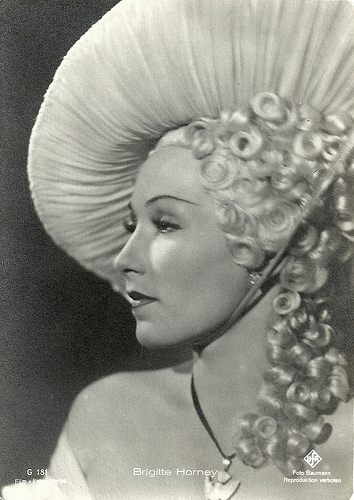
German postcard by Film-Foto-Verlag, no. G 181. Photo: Baumann.
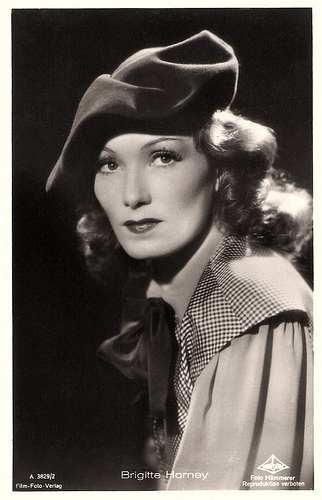
German postcard by Film-Foto-Verlag, no. A 3829/2, 1941-1944. Photo: Hämmerer / Wien Film.
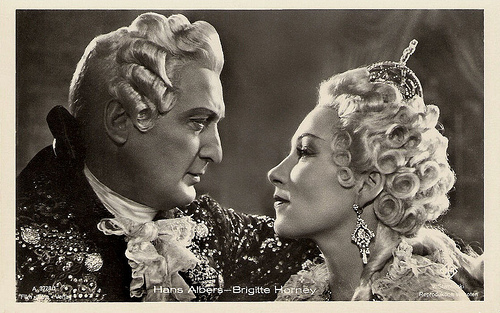
German postcard by Film-Foto-Verlag, no. A 3728/1, 1941-1944. Photo: V. Swolinski/Ufa. Publicity still for Munchhausen/The Adventures of Baron Munchausen (Josef von Baky, 1943) with Hans Albers .
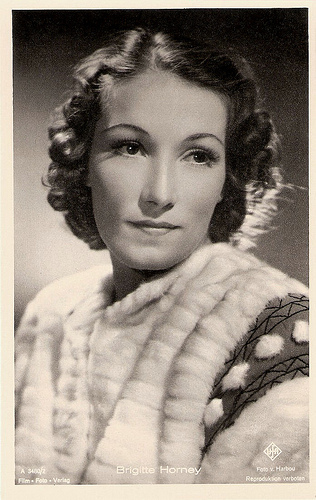
German postcard by Film-Foto-Verlag, no. A 3480/2, 1941-1944. Photo: Ufa / V. Harbou.
Aunt Polly
After the war, Brigitte Horney first acted in Zurich and Basel, including a Swiss production of Jean-Paul Sartre's Les Mains Sales/Dirty Hands (1949). She also appeared in films in Austria. The post-war cinema offered her - with a few exceptions - no demanding roles.
In 1952 she moved to the US to open the Karen Horney clinic in New York City, in honour of her mother’s achievements. There she married art historian Hanns Swarzenski and received the American nationality in 1953. She visited Germany frequently, and had a house in Bavaria.
She continued to work in films like Solange Du da bist/As Long as You're Near Me (Harald Braun, 1953) with O.W. Fischer , Der letzte Sommer/The Last Summer (Harald Braun, 1954) starring Hardy Krüger , Der gläserne Turm/The Glass Tower (Harald Braun, 1957) with Lilli Palmer , and the Edgar Wallace Krimi The Trygon Factor (Cyril Frankel, 1966) with Stewart Granger .
During her later years she became a popular TV star as Aunt Polly in the Canadian-German children’s series Huckleberry Finn and His Friends (1980). On TV she also appeared in the popular series Jakob und Adele (Hans Jürgen Tögel, 1983-1986) with Carl-Heinz Schroth and the soap Das Erbe der Guldenburgs/The Guldenburg Heritage (1986–1988).
She incidentally appeared in interesting films as the war drama Charlotte (Frans Weisz, 1981) with Birgit Doll as the Jewish painter Charlotte Salomon, and Bella Donna (Peter Keglevic, 1983) with Harry Baer and Krystyna Janda. She also played a supporting role in Fassbinder's Die Sehnsucht der Veronika Voss/Veronika Voss (Rainer Werner Fassbinder, 1982), based on the life of one of her contemporaries, the haunting Sybille Schmitz .
Brigitte Horney died by cancer in 1988, in Hamburg, Germany. She was honoured with several German awards, the Bambi in 1965, the Filmband in Gold in 1972, the Goldene Kamera in 1981 and the Telestar in 1987.
Brigitte Horney sings So oder so ist das Leben in Liebe, Tod und Teufel/Love, Death and the Devil (1934). Source: Alparfan (YouTube).
Scenes from Baron Munchhausen (1943). Source: classicmovieslibrary (YouTube).
Eddi Arent, Brigitte Horney, Robert Morley and Cathleen Nesbitt in The Trygon Factor (1966). Source: whatchawatchabar (YouTube).
Opening and closing titles of Huckleberry Finn and His Friends (1980). Source: eurochrissy2 (YouTube).
Sources: Thomas Staedeli (Cyranos), Hans J. Wollstein (AllMovie), Stanislas Lefort (IMDb), Wikipedia, and .

German postcard by Ross-Verlag, no. 9238/1, 1935-1936. Photo: Ufa.

German postcard by Ross-Verlag, no. 9828/1, 1935-1936. Photo: Ufa.

German postcard by Ross-Verlag, no. A 2745, 1941-1944.

German postcard by Film-Foto-Verlag, no. G 228. Photo: Hämmerer.

German postcard by Ross Verlag, no. A 1899/1, 1941-1944. Photo: Ufa / Hämmerer.
Forgotten Masterpiece
Brigitte Horney was born in 1911, in Berlin-Dahlem, Germany. She was the daughter of Karen Horney-Danielsen, a noted German psychoanalyst, and Oscar Horney, an industrialist from Berlin. She had a bilingual education. Brigitte attended lessons for expressive dance by the legendary Mary Wigman and also acting classes by actress Ilka Grüning at the Ilka-Grüning-Schule in Berlin.
She began her stage career in Würzburg, and was, for more than a decade, engaged by Berlin's Volksbühne. Already in 1930 she won the Max-Reinhardt-Preis as up-and-coming actress. Young director Robert Siodmak discovered her for the cinema and cast her as a sales clerk in his film Abschied/Farewell (Robert Siodmak, 1930), the first sound film of the Ufa and according to reviewer Stanislas Lefort at IMDb a ‘forgotten masterpiece’.
The young actress refused the contract that Ufa offered her, because she wanted to continue her stage career. But in the next years Horney would also appear in films like Fra Diavolo (Mario Bonnard, 1931), Rasputin, Dämon der Frauen/Rasputin (Adolf Trotz, 1932) featuring Conrad Veidt , and Ein Mann will nach Deutschland/A Man Wants to Get to Germany (Paul Wegener, 1934) with Karl Ludwig Diehl .
Although her mother had escaped to New York, Horney opportunistically remained in the Third Reich. When she accepted the starring role as a waterfront girl in in the highly popular film Liebe, Tod und Teufel/Love, Death and the Devil (Heinz Hilpert, Reinhart Steinbicker, 1934) with Käthe von Nagy . A new star was born when she sang in her inimitable husky voice So oder so ist das Leben (So or so is life), written by Theo Mackeben. It became her Leitmotiv song. Critics and audiences alike compared her favorably to Marlene Dietrich .
This success was followed by such films as Savoy-Hotel 217 (Gustav Ucicky, 1936) opposite Hans Albers , the English films The House of the Spaniard (Reginald Denham, 1936) and Secret Lives (Edmond T. Gréville, 1937) as well as Der Katzensteg/The Cat’s Alley (Fritz Peter Buch, 1937), Anna Favetti (Erich Waschneck, 1938) with Mathias Wieman, and Befreite Hände/Freed Hands (Hans Schweikart, 1939) with Olga Tschechova . In these films she often played strong women, not unlike herself.

German postcard by Ross-Verlag, no. 3378/1, 1941-1944. Photo: Bavaria / Binz.

German postcard by Film-Foto-Verlag, no. 3667/1, 1941-1944. Photo: Baumann / Ufa.

German postcard by Film-Foto-Verlag, no. A 3480/1, 1941-1944. Photo: Ufa / Baumann.

German postcard by Film-Foto-Verlag, no. A 3829/1, 1941-1944. Photo: Hämmerer / Wien Film.

Big German card by Film-Foto-Verlag, no. W 83, 1941-1944. Photo: Wien-Film / Hämmerer.
Tuberculosis
When Brigitte Horney appeared at Joachim Gottschalk 's side in Du und ich/You and I (Wolfgang Liebeneiner, 1938) the result was a splendid success and they continued to work successfully as a pair in Aufruhr in Damaskus/Tumult in Damascus (Gustav Ucicky, 1939), Eine Frau wie Du/A Woman Like You (Viktor Tourjansky, 1939) and eventually Das Mädchen von Fanö/The Girl From the Isle of Fanö (Hans Schweikart, 1940).
The cooperation was destroyed when Joachim Gottschalk was ordered by the Nazis to leave his Jewish wife. The family Gottschalk committed suicide in 1941 - one day before their deportation. Horney and Gottschalk had been good friends and Horney attended with only four other people his funeral in 1941, regardless of the political and career implications of doing so.
Till the end of the war she took only part in a few more films and she is maybe best remembered for her role as Empress Catherine the Great in the Ufa production Münchhausen/Baron Munchhausen (Josef von Baky, 1943), with Hans Albers in the title role.
Josef Goebbels, Reichsminister of propaganda and also chief of the Ufa Studios, ordered this film to be made for the 25th anniversary of Ufa. Ironically the banned author Erich Kästner worked on this film and included some digs at the Nazi regime, such as a villain with a moustache talking about invading Poland. During the war he was hidden in Horney's house in Neubabelsberg where he could write on under a pseudonym.
Horney soldiered on in her own way - filming the prophetically titled Am Ende der Welt/The End of the World (Gustav Ucicky, 1944) while bombs were literally dropping around her. She finally fled to Switzerland in early 1945, with her husband, the Russian cinematographer Konstantin Irmen-Tschet. There she fell ill with tuberculosis and the newspapers even announced her death in 1946, but she answered the condolences herself.

German postcard by Film-Foto-Verlag, no. G 181. Photo: Baumann.

German postcard by Film-Foto-Verlag, no. A 3829/2, 1941-1944. Photo: Hämmerer / Wien Film.

German postcard by Film-Foto-Verlag, no. A 3728/1, 1941-1944. Photo: V. Swolinski/Ufa. Publicity still for Munchhausen/The Adventures of Baron Munchausen (Josef von Baky, 1943) with Hans Albers .

German postcard by Film-Foto-Verlag, no. A 3480/2, 1941-1944. Photo: Ufa / V. Harbou.
Aunt Polly
After the war, Brigitte Horney first acted in Zurich and Basel, including a Swiss production of Jean-Paul Sartre's Les Mains Sales/Dirty Hands (1949). She also appeared in films in Austria. The post-war cinema offered her - with a few exceptions - no demanding roles.
In 1952 she moved to the US to open the Karen Horney clinic in New York City, in honour of her mother’s achievements. There she married art historian Hanns Swarzenski and received the American nationality in 1953. She visited Germany frequently, and had a house in Bavaria.
She continued to work in films like Solange Du da bist/As Long as You're Near Me (Harald Braun, 1953) with O.W. Fischer , Der letzte Sommer/The Last Summer (Harald Braun, 1954) starring Hardy Krüger , Der gläserne Turm/The Glass Tower (Harald Braun, 1957) with Lilli Palmer , and the Edgar Wallace Krimi The Trygon Factor (Cyril Frankel, 1966) with Stewart Granger .
During her later years she became a popular TV star as Aunt Polly in the Canadian-German children’s series Huckleberry Finn and His Friends (1980). On TV she also appeared in the popular series Jakob und Adele (Hans Jürgen Tögel, 1983-1986) with Carl-Heinz Schroth and the soap Das Erbe der Guldenburgs/The Guldenburg Heritage (1986–1988).
She incidentally appeared in interesting films as the war drama Charlotte (Frans Weisz, 1981) with Birgit Doll as the Jewish painter Charlotte Salomon, and Bella Donna (Peter Keglevic, 1983) with Harry Baer and Krystyna Janda. She also played a supporting role in Fassbinder's Die Sehnsucht der Veronika Voss/Veronika Voss (Rainer Werner Fassbinder, 1982), based on the life of one of her contemporaries, the haunting Sybille Schmitz .
Brigitte Horney died by cancer in 1988, in Hamburg, Germany. She was honoured with several German awards, the Bambi in 1965, the Filmband in Gold in 1972, the Goldene Kamera in 1981 and the Telestar in 1987.
Brigitte Horney sings So oder so ist das Leben in Liebe, Tod und Teufel/Love, Death and the Devil (1934). Source: Alparfan (YouTube).
Scenes from Baron Munchhausen (1943). Source: classicmovieslibrary (YouTube).
Eddi Arent, Brigitte Horney, Robert Morley and Cathleen Nesbitt in The Trygon Factor (1966). Source: whatchawatchabar (YouTube).
Opening and closing titles of Huckleberry Finn and His Friends (1980). Source: eurochrissy2 (YouTube).
Sources: Thomas Staedeli (Cyranos), Hans J. Wollstein (AllMovie), Stanislas Lefort (IMDb), Wikipedia, and .
Published on February 12, 2016 22:00
Paul van Yperen's Blog
- Paul van Yperen's profile
- 13 followers
Paul van Yperen isn't a Goodreads Author
(yet),
but they
do have a blog,
so here are some recent posts imported from
their feed.



